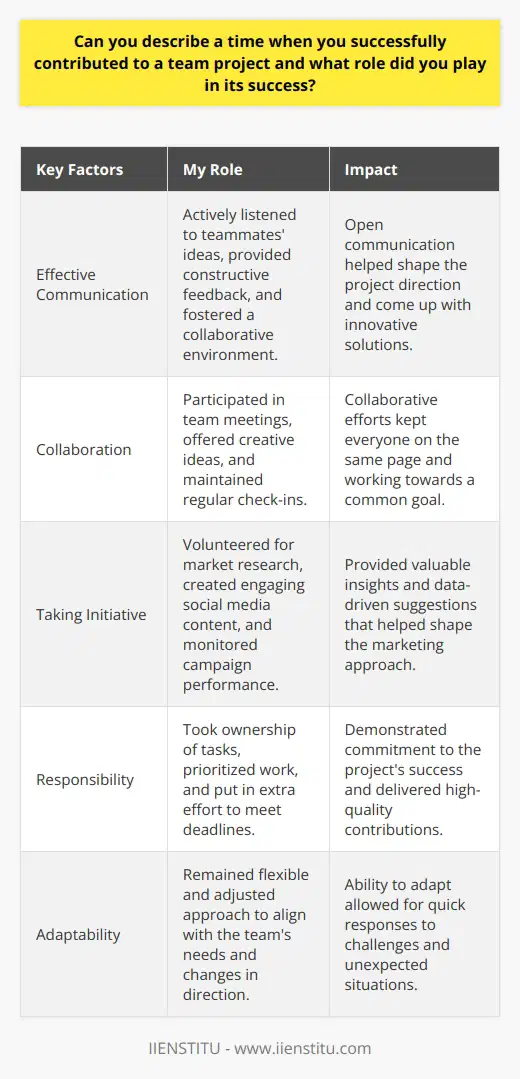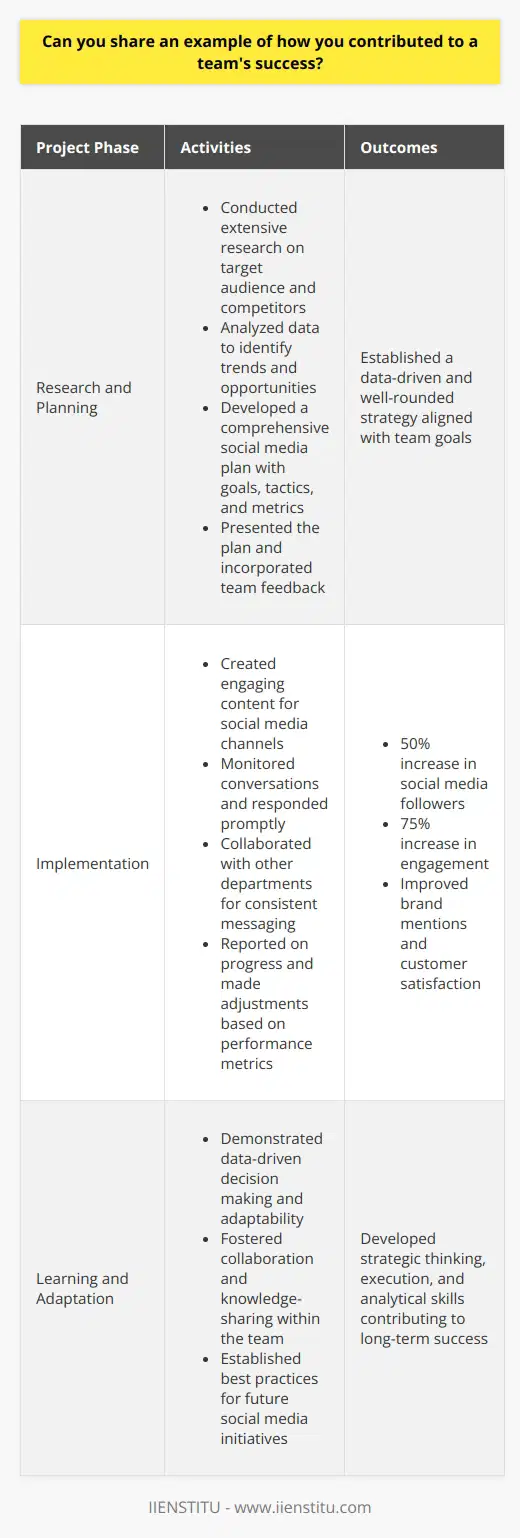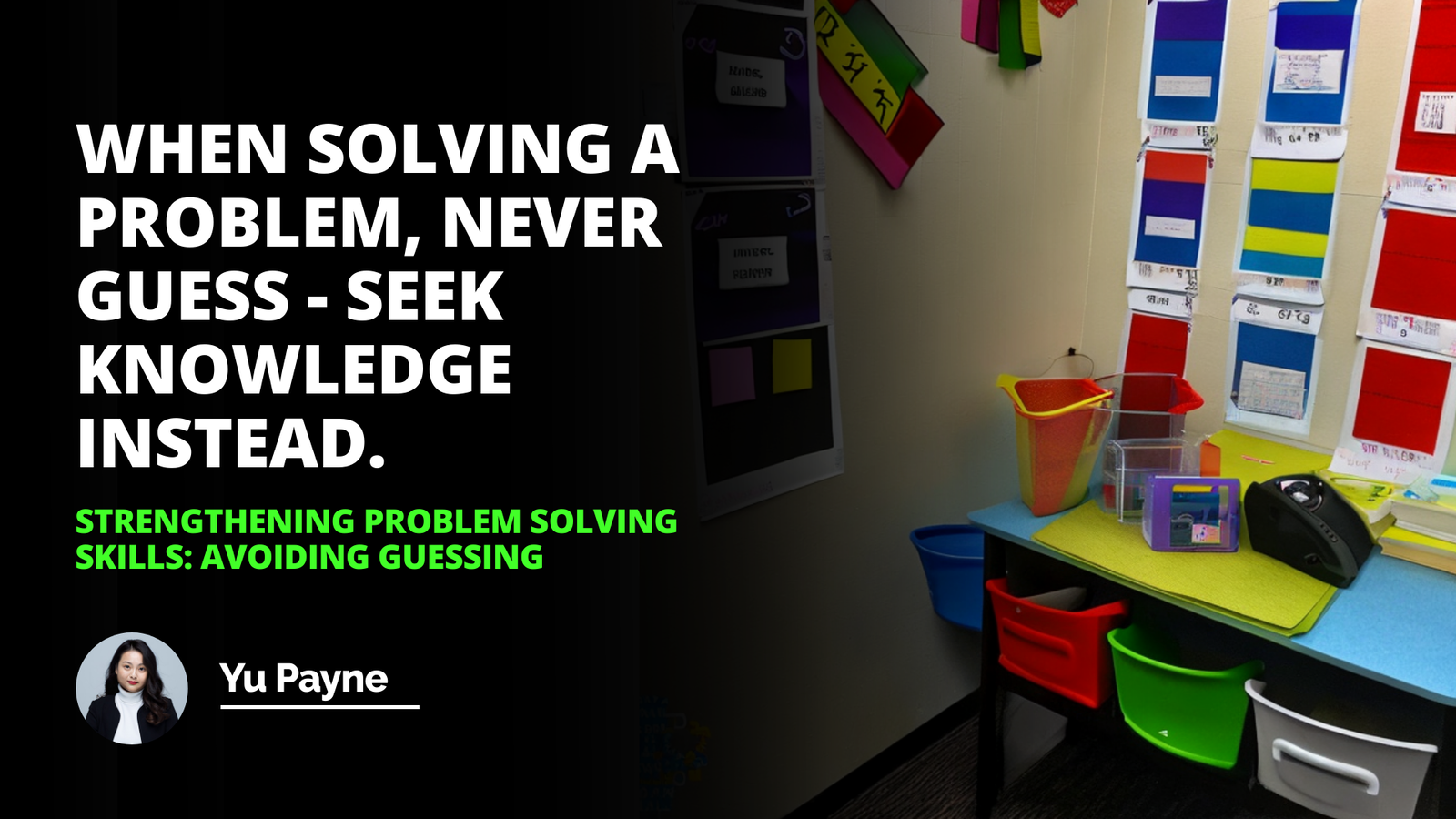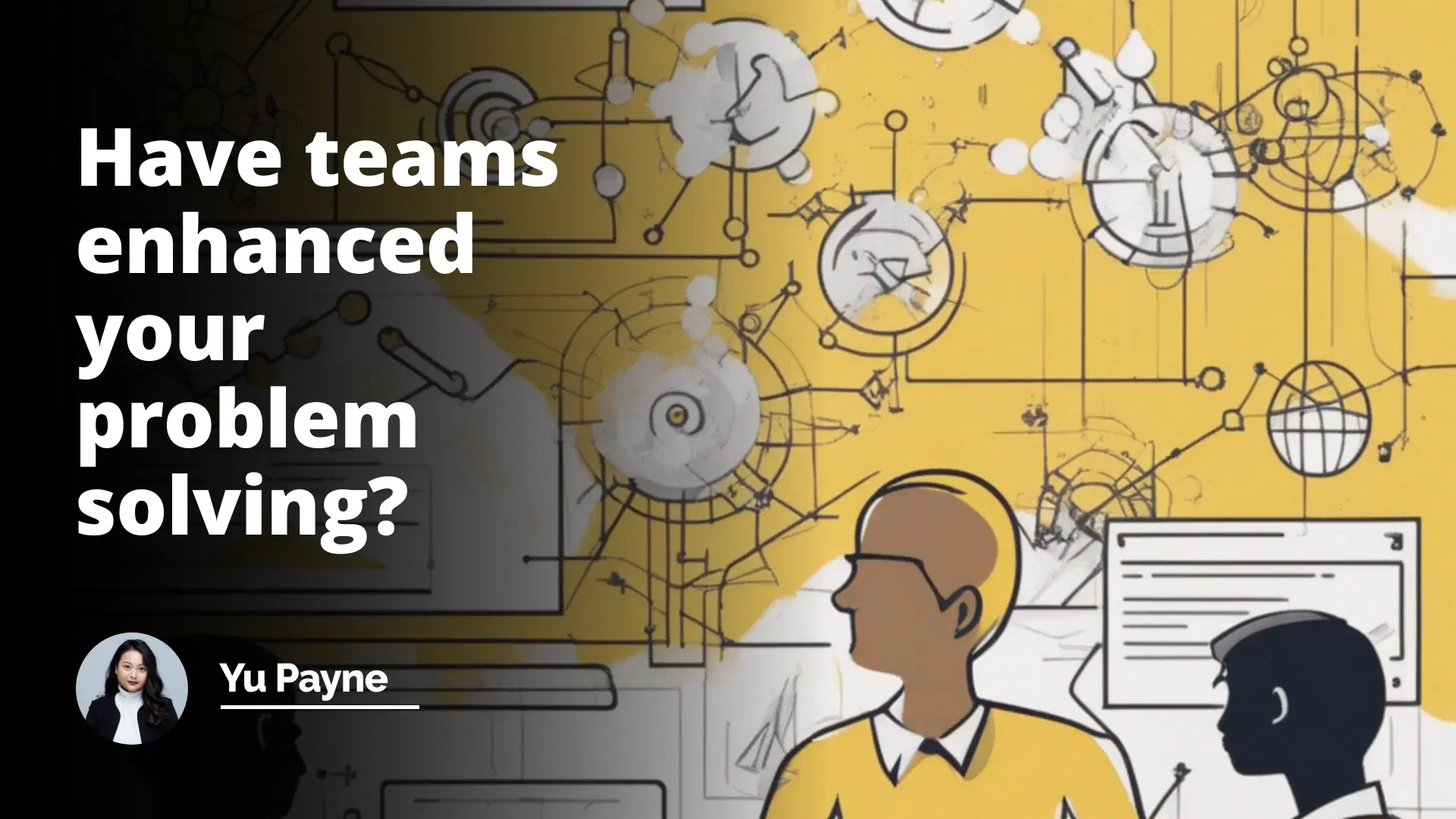
You know, I still remember the first time I truly understood the power of teamwork in enhancing problem-solving abilities. It was early in my career when I was part of a small team tasked with developing a new marketing strategy for a product launch. We were all a bit nervous but also excited about the challenge ahead.
How Teams Have Enhanced My Problem-Solving Skills
Working within a team has genuinely transformed the way I approach problems. Before, I used to believe that tackling issues independently was the most efficient route. However, collaborating with others has opened my eyes to new perspectives and ideas that I might never have considered on my own.
One experience stands out vividly. Our team was facing a tight deadline to deliver a project, and we encountered a significant roadblock. Individually, we were stumped. But when we came together for a brainstorming session—over coffee and donuts, of course—the synergy was incredible. Ideas started flowing, and we pieced together a solution that not only met our deadline but also improved the project's overall quality.
Long Tail Keyword Example: How To Answer Have You Used Analytics İn Logistics İnterview Question
İnterview Question Ensuring Security And İntegrity İn Supply Chains
The Role of Team Building Activities
Through team building activities, we strengthened our relationships and communication skills. Activities like trust exercises and problem-solving games weren't just fun—they were instrumental in helping us work better together. Team training activities such as workshops on effective communication and collaboration techniques significantly enhanced our ability to tackle complex problems as a cohesive unit.
Example Answer 1: Yes, teams have greatly enhanced my problem-solving abilities. In my previous role as a project manager, I led a cross-functional team where each member brought unique perspectives and expertise.
By fostering open communication and active collaboration, we were able to brainstorm innovative solutions to complex challenges.
Example Answer 2: Absolutely! Working in a team has sharpened my problem-solving skills significantly. In my previous role as a software developer, our team faced a critical issue with a complex software bug.
Through collaborative problem-solving sessions and leveraging the diverse skills within the team, we were able to diagnose and fix the bug efficiently.
Be specific: Provide concrete examples of how you have contributed to solving problems as part of a team. This demonstrates your practical experience and expertise.
Highlight teamwork and collaboration: Emphasize your ability to work effectively with others, communicate clearly, and listen to different perspectives. This demonstrates your interpersonal skills and ability to leverage the collective intelligence of a team.
Show adaptability and flexibility: Discuss situations where you were open to different approaches and willing to adjust your problem-solving strategies based on input from team members. This shows your ability to be flexible and responsive in a team setting.
Discuss successful outcomes: When sharing your experiences, highlight the positive results that were achieved through effective teamwork and problem-solving. This showcases your ability to deliver tangible solutions as part of a team.
Understanding the Interview Question
When an interviewer asks, "Have teams enhanced your problem solving?", they're delving into more than just your ability to solve problems. They're assessing your capacity to collaborate, communicate, and integrate into their team dynamics. It's one of those common interview questions that can reveal a lot about a candidate's interpersonal skills and professional approach.
At What Interview Levels Is This Question Asked?
From my experience, this question is relevant across all levels—from entry-level positions to senior management roles. Whether you're a recent graduate or a seasoned professional, your ability to work effectively within a team is crucial. I've faced this question in several interviews, and each time, I made sure to highlight specific examples that demonstrated my collaborative problem-solving skills.
How have teams positively impacted your problem-solving abilities?
In what ways have teams contributed to improving your problem-solving skills?
Have teams proven to be an effective tool in enhancing your problem-solving capabilities?
To what extent have teams positively influenced the way you approach and solve problems?
Can you elaborate on the effects of working in teams when it comes to problem-solving
Could you elucidate the ways in which teams have enhanced your problem-solving capabilities?
How do you believe teams have impacted your problem-solving skills?
What role have teams played in developing your problem-solving abilities?
Can you discuss the impact of teamwork on improving your problem-solving aptitude?
Please describe how teams have positively influenced your problem-solving competence.

Crafting the Right Answer
So, what's the best way to answer this question? Here are some points to consider:
1- Be Specific: Provide concrete examples of situations where teamwork led to successful problem-solving.
2- Highlight Teamwork and Collaboration: Emphasize how working with others enhanced the outcome.
3- Show Adaptability and Flexibility: Discuss how you were open to different approaches and learned from your teammates.
4- Discuss Successful Outcomes: Share the positive results that came from the collaborative effort.
5- Reflect on Personal Growth: Explain how these experiences have shaped your approach to problem-solving.
Possible Answers to Consider
Example Answer 1:
"Absolutely, teams have significantly enhanced my problem-solving abilities. In my previous role, our department faced a critical challenge in streamlining our project management processes. By collaborating with my colleagues through regular team development activities, we adopted a critical path method project management strategy. This collective effort not only improved efficiency but also fostered a sense of unity within the team."
Example Answer 2:
"Yes, working in teams has been instrumental in enhancing my problem-solving skills. For instance, during a major project, we encountered a complex issue that required innovative solutions. Through team building activities for teams, we fostered a collaborative environment where everyone felt comfortable sharing ideas. Together, we developed a solution that exceeded our initial expectations."
The Impact of Teamwork on Problem Solving
Variety in Perspectives
One of the most significant benefits of teamwork is the diversity of perspectives it brings. Different team members come with unique experiences, skills, and ways of thinking. This variety can lead to more creative and effective solutions.
Bold Insight: Diverse teams can outperform homogeneous ones in problem-solving tasks by 20%, according to research from the Journal of Applied Psychology (Williams & O'Reilly, 1998).
Collaboration and Brainstorming
Collaborative environments encourage open communication and idea-sharing. Brainstorming sessions are not just about throwing ideas around; they're about building on each other's thoughts to create something better than any individual could have conceived alone.
Benefits of Team Collaboration:
Enhanced Creativity: Combining different viewpoints can spark innovative ideas.
Faster Problem Solving: Teams can tackle complex issues more quickly than individuals.
Knowledge Sharing: Team members can learn from each other's expertise.
Problem-Solving Efficiency: Teams vs. Individuals
While individuals can certainly solve problems effectively, teams often bring solutions to fruition more efficiently. The shared workload and collective brainstorming can accelerate the problem-solving process.
Italicized Fact: Working in teams can increase productivity by up to 25%, as noted in "The Wisdom of Teams" by Katzenbach and Smith (1993).
Similar Interview Questions
It's essential to recognize that interviewers may phrase the question differently. Here are some variations you might encounter:
1- "How have teams positively impacted your problem-solving abilities?"
2- "Can you discuss the impact of teamwork on improving your problem-solving aptitude?"
3- "What role have teams played in developing your problem-solving abilities?"
4- "Could you elucidate the ways in which teams have enhanced your problem-solving capabilities?"
5- "Please describe how teams have positively influenced your problem-solving competence."
Tips for Answering Effectively
When faced with such questions, here are some strategies to help you formulate a compelling response:
Prepare Ahead: Reflect on past experiences where teamwork played a crucial role.
Use the STAR Method: Situation, Task, Action, Result—it's a great way to structure your answer.
Be Honest: Authenticity resonates more than rehearsed answers.
Ask for Clarification: If unsure about the question, don't hesitate to ask for clarification.
Asking Questions in Return
Towards the end of an interview, you'll often have the opportunity to ask your own questions. This is a perfect moment to delve deeper into the company's culture and expectations.
Good Questions to Ask in an Interview
"Can you describe the team's dynamic and how collaboration is fostered?"
"What team building activities does the company engage in to enhance teamwork?"
"How does the organization support professional development and team training?"
Asking such great interview questions not only shows your interest in the role but also demonstrates that you value teamwork and continuous improvement.
The Importance of Team Building in Organizations
Organizations today recognize that effective teamwork is essential for success. Implementing team development activities and team building activities for teams helps in:
Improving Communication: Better exchanges lead to fewer misunderstandings.
Building Trust: Teams that trust each other work more efficiently.
Enhancing Morale: A positive team environment boosts overall morale.
IT Team Building Activities
In the realm of IT, where I spend much of my time, IT team building activities are crucial. They help bridge the gap between technical and non-technical team members, ensuring everyone is on the same page.
Examples of Effective IT Team Building Activities:
1- Code Retreats: Collaborative programming sessions to improve coding skills.
2- Hackathons: Team-based problem-solving events to innovate new solutions.
3- Tech Workshops: Sharing knowledge on the latest technologies and best practices.
Personal Experiences with Team Building
Reflecting on my career, some of the most rewarding moments have come from participating in team building teams. These experiences have not only enhanced my professional skills but also led to lasting friendships.
I recall a time when our team was struggling with low morale due to a high-pressure project. Our manager organized a weekend retreat focused on team building and relaxation. Through various activities—like trust falls (yes, they actually work!), hiking, and group discussions—we reconnected on a personal level. The following week, we returned to work rejuvenated and more cohesive than ever.
Underlined Outcome: That retreat didn't just boost our spirits; it directly improved our collaboration and problem-solving efficiency.
The Psychological Perspective
From a psychological standpoint, teamwork satisfies the human need for social connection and belongingness. According to Maslow's hierarchy of needs, once our basic needs are met, social connections become a primary motivator (Maslow, 1943).
Psychological Benefits of Teamwork:
Reduced Stress: Sharing the workload can alleviate individual pressure.
Increased Motivation: Team support can boost individual drive.
Enhanced Learning: Learning from others promotes personal growth.
Embracing Teamwork in Remote Settings
With the rise of remote work, fostering teamwork has become more challenging yet even more critical. Virtual team building activities have emerged as essential tools for maintaining team cohesion.
Effective Remote Team Building Strategies:
1- Virtual Coffee Breaks: Casual chats to maintain personal connections.
2- Online Games and Challenges: Fun activities to encourage teamwork.
3- Regular Video Meetings: Keeping communication lines open.
Conclusion
In wrapping up, it's clear that teams have profoundly enhanced my problem-solving abilities. The collective intelligence, diverse perspectives, and shared experiences that come from working in a team are invaluable. So when faced with the interview question, "Have teams enhanced your problem solving?", seize the opportunity to share your stories and demonstrate how teamwork has shaped your professional journey.
References
Katzenbach, J. R., & Smith, D. K. (1993). The Wisdom of Teams: Creating the High-Performance Organization. Harvard Business School Press.
Maslow, A. H. (1943). "A Theory of Human Motivation". Psychological Review, 50(4), 370-396.
Williams, K. Y., & O'Reilly, C. A. (1998). "Demography and Diversity in Organizations: A Review of 40 Years of Research". Research in Organizational Behavior, 20, 77-140.
Note: The insights shared are based on personal experiences and well-established theories in organizational behavior. For those preparing for interviews, reflecting on how teamwork has enhanced your problem-solving skills can provide a compelling narrative that resonates with potential employers.
Frequently Asked Questions
What strategies do you employ to foster effective communication and collaboration within a team?
Effective communication and collaboration within a team are essential for achieving shared goals and fostering a positive work environment. Several strategies can be employed to promote these critical aspects of teamwork. First, establish clear channels of communication, such as regular team meetings, email updates, and project management tools. These channels ensure that all team members are informed and engaged in the project's progress.
Encouraging Open Dialogue
Encourage open dialogue among team members by creating a safe and inclusive space for sharing ideas and concerns. Actively listen to each other and provide constructive feedback to build trust and rapport within the team. Promote a culture of transparency and honesty, where team members feel comfortable expressing their thoughts and opinions without fear of judgment or retribution.
Defining Roles and Responsibilities
Clearly define roles and responsibilities for each team member to minimize confusion and duplication of efforts. Ensure that everyone understands their individual tasks and how they contribute to the overall project goals. Regularly review and adjust these roles as needed to maintain optimal team performance and adapt to changing circumstances.
Fostering a Collaborative Environment
Foster a collaborative environment by encouraging teamwork and cross-functional cooperation. Organize team-building activities and promote a sense of camaraderie among team members. Celebrate successes together and learn from failures as a team. Encourage team members to support and assist each other when needed, creating a strong sense of unity and shared purpose.
Resolving Conflicts Effectively
Address conflicts promptly and effectively to maintain a healthy team dynamic. Encourage open and respectful communication when disagreements arise. Seek to understand different perspectives and find mutually beneficial solutions. Employ conflict resolution techniques, such as mediation or problem-solving sessions, to resolve issues and maintain team harmony.
By implementing these strategies, teams can foster effective communication and collaboration, leading to increased productivity, innovation, and job satisfaction. Continuously evaluate and refine these approaches to ensure that the team remains cohesive and aligned with organizational goals.
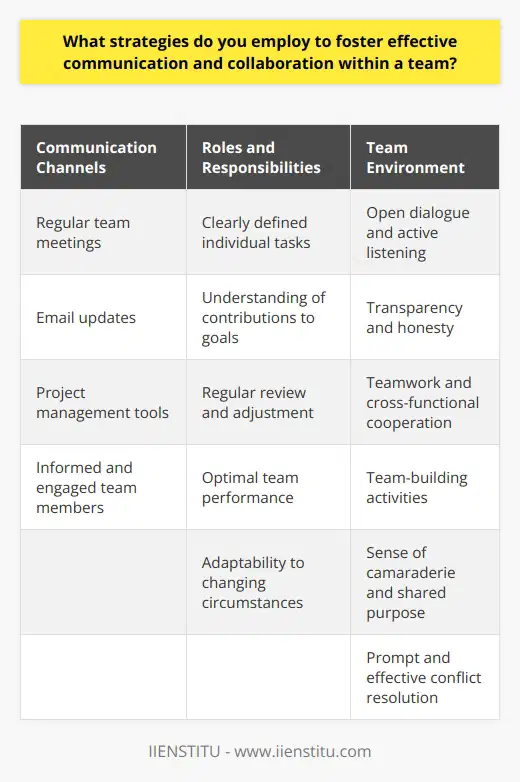
How do you handle conflicts or disagreements that may arise among team members?
Handling conflicts or disagreements among team members is a crucial aspect of effective team management. Open communication is key to resolving conflicts and fostering a positive team dynamic. Encourage team members to express their concerns and viewpoints respectfully and actively listen to one another. When conflicts arise, it's essential to address them promptly and objectively.
Identify the Root Cause
To resolve conflicts effectively, identify the underlying issues causing the disagreement. Arrange a meeting with the involved team members and encourage them to share their perspectives. Ask questions to gain a comprehensive understanding of the situation and avoid making assumptions. Once the root cause is identified, work together to find a mutually agreeable solution.
Promote Collaboration and Compromise
Encourage team members to collaborate and find common ground when disagreements occur. Emphasize the importance of focusing on the team's goals and objectives rather than personal differences. Help team members understand each other's viewpoints and facilitate a discussion to reach a compromise. Encourage them to find creative solutions that benefit the team as a whole.
Establish Clear Roles and Responsibilities
Clearly define each team member's roles and responsibilities to minimize conflicts arising from misunderstandings or overlapping tasks. Ensure that everyone understands their duties and how their work contributes to the team's success. Regular check-ins and updates can help prevent conflicts by keeping everyone informed and aligned.
Foster a Positive Team Culture
Create a team culture that values respect, trust, and open communication. Encourage team members to appreciate diversity and treat each other with kindness and professionalism. Lead by example and demonstrate the importance of collaboration and mutual support. Regularly recognize and celebrate the team's successes to boost morale and strengthen bonds.
Provide Conflict Resolution Training
Invest in conflict resolution training for team members to equip them with the skills needed to handle disagreements effectively. Teach active listening, assertive communication, and problem-solving techniques. Encourage team members to apply these skills when conflicts arise and provide ongoing support and guidance.
Seek External Mediation if Necessary
In cases where conflicts persist or escalate, consider seeking the help of an external mediator. An impartial third party can provide a fresh perspective and facilitate a constructive dialogue between the conflicting team members. They can help identify the underlying issues and guide the team towards a resolution.
By addressing conflicts promptly, promoting open communication, and fostering a positive team culture, managers can effectively handle disagreements among team members. Investing in conflict resolution skills and seeking external support when necessary can further strengthen the team's ability to overcome challenges and work together harmoniously towards common goals.
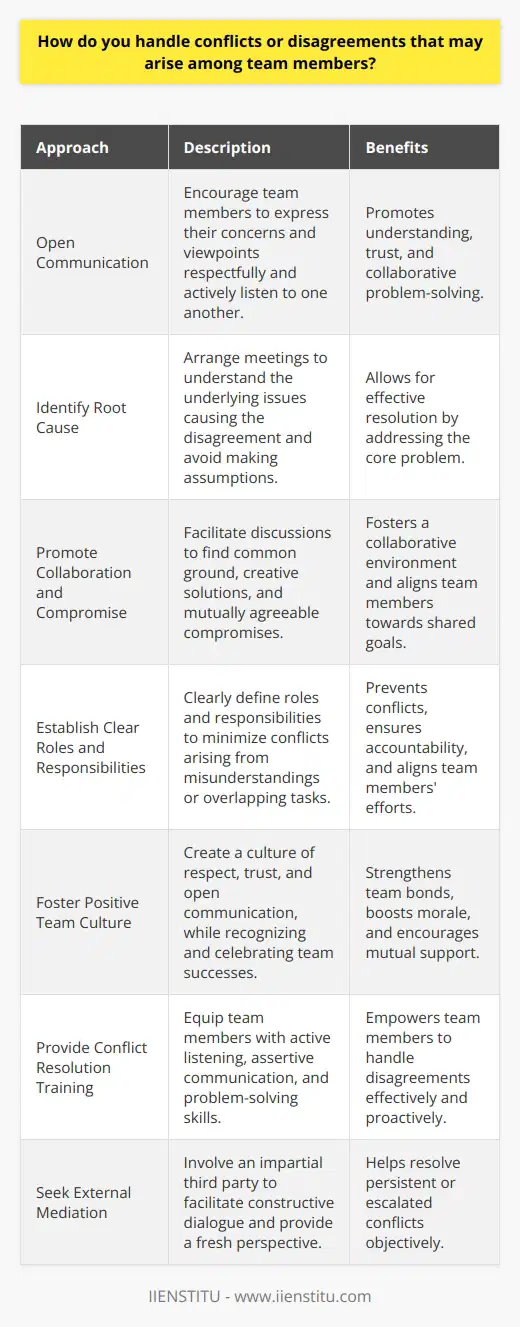
Can you describe a time when you had to adapt your working style to fit the dynamics of a particular team?
Adapting one's working style to fit the dynamics of a particular team is a crucial skill in any professional setting. I encountered a situation that required me to modify my approach while working on a marketing campaign. The team consisted of individuals with diverse backgrounds and preferences for communication and collaboration.
Understanding Team Dynamics
To effectively adapt, I first observed and analyzed the team's dynamics. I noticed some members preferred frequent updates and discussions, while others favored more autonomy. Recognizing these differences helped me tailor my working style to meet the team's needs.
Adjusting Communication Style
I adjusted my communication style to ensure everyone felt informed and included. For team members who appreciated regular updates, I scheduled brief daily check-ins. With those who preferred less frequent communication, I established weekly progress reports.
Embracing Collaboration
I also adapted my approach to collaboration. I initiated brainstorming sessions that encouraged open dialogue and idea-sharing. This fostered a sense of unity and ensured everyone's perspectives were considered.
Balancing Individual and Team Goals
Adapting my working style also meant balancing individual and team goals. I made sure to align my tasks with the overall objectives of the campaign. By prioritizing the team's success, I demonstrated flexibility and a commitment to collective achievement.
Leading by Example
As I adapted my working style, I aimed to lead by example. I actively listened to team members and valued their input. By showing respect and openness, I encouraged others to do the same.
Encouraging Open Communication
I created an environment that promoted open communication. I regularly sought feedback from the team and addressed any concerns promptly. This approach fostered trust and collaboration among team members.
Positive Outcomes
Adapting my working style to fit the team's dynamics yielded positive results. We achieved our marketing campaign goals ahead of schedule. Moreover, the team reported higher levels of satisfaction and engagement.
Lessons Learned
This experience taught me the importance of flexibility and adaptability in teamwork. By understanding and accommodating different working styles, we can create a more cohesive and productive team environment.
In conclusion, adapting one's working style to fit team dynamics is essential for success. It requires observing, communicating effectively, collaborating, and leading by example. By embracing flexibility, we can foster strong teams and achieve remarkable results.
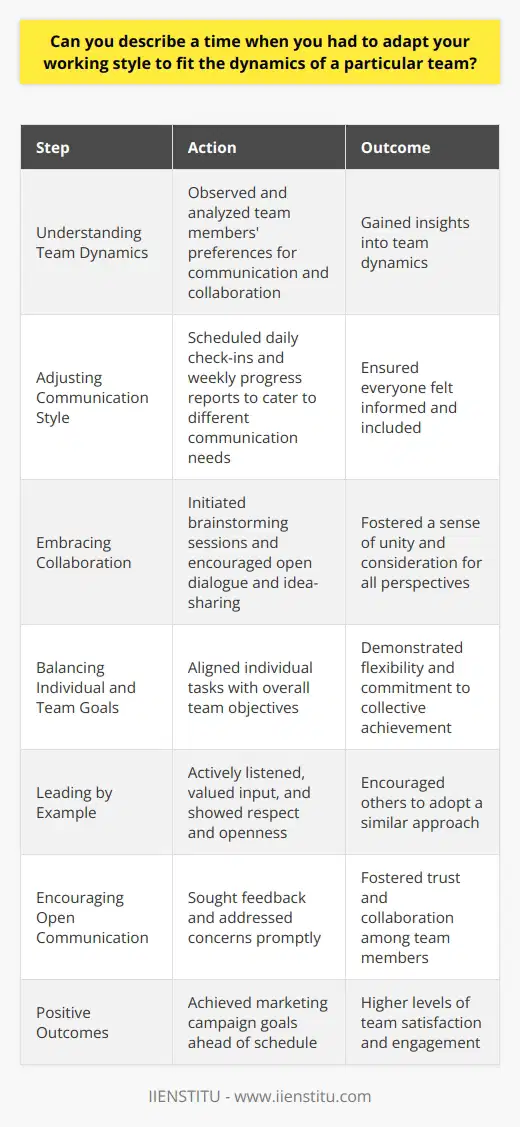
Tell me about a time when you collaborated with a team to achieve a common goal?
Collaborating with a team to achieve a common goal is an essential skill in various aspects of life. One notable instance where I experienced the power of teamwork was during my final year of university. Our class was tasked with organizing a charity event to raise funds for a local non-profit organization that supported underprivileged children in the community.
Forming the Team
The first step was to form a team of dedicated individuals who shared the same passion for making a difference. I volunteered to lead the team, and we quickly gathered a group of ten students with diverse skills and backgrounds. We held our initial meeting to discuss the objectives, brainstorm ideas, and assign roles and responsibilities to each team member.
Planning and Preparation
The team collaborated closely to develop a comprehensive plan for the charity event. We decided to organize a family-friendly carnival that would appeal to both children and adults in the community. Each team member contributed their unique skills and expertise to ensure the success of the event.
Some team members focused on securing sponsors and donations, while others worked on marketing and promotion strategies. We also had a dedicated group responsible for planning the logistics, including venue selection, equipment rental, and volunteer recruitment. Regular meetings were held to track progress, address challenges, and make necessary adjustments to our plan.
Execution and Teamwork
On the day of the event, the team arrived early to set up the carnival grounds. We worked together seamlessly, assisting each other in various tasks such as setting up booths, decorating the venue, and coordinating with volunteers. Throughout the day, we maintained open communication, ensuring that everyone was aware of their responsibilities and supporting one another when needed.
The event was a resounding success, attracting hundreds of attendees and raising a significant amount of funds for the non-profit organization. The team's dedication, hard work, and collaborative spirit were evident in every aspect of the carnival.
Reflection and Lessons Learned
Reflecting on this experience, I learned valuable lessons about the importance of effective teamwork. Clear communication, trust, and a shared vision were key factors in our success. Each team member brought their unique strengths to the table, and by leveraging these diverse skills, we were able to overcome challenges and achieve our common goal.
Communication is Key
Throughout the planning and execution stages, open and transparent communication was crucial. We regularly shared updates, discussed ideas, and provided constructive feedback to one another. This fostered a sense of trust and ensured that everyone was aligned and working towards the same objectives.
Leveraging Diversity
Our team consisted of individuals with different backgrounds, skills, and perspectives. Instead of seeing this diversity as a challenge, we embraced it as a strength. Each team member contributed their unique expertise, whether it was in marketing, event planning, or community outreach. By leveraging this diversity, we were able to develop creative solutions and execute a successful event.
Adaptability and Resilience
Despite our thorough planning, unexpected challenges arose during the event. However, the team remained adaptable and resilient. We quickly adjusted our strategies, collaborated to find solutions, and supported one another through difficult moments. This adaptability and resilience were essential in overcoming obstacles and ensuring the smooth running of the carnival.
In conclusion, this experience taught me the power of collaboration and teamwork in achieving a common goal. By forming a dedicated team, planning meticulously, and working together seamlessly, we were able to organize a successful charity event that made a positive impact in our community. The lessons learned, such as the importance of communication, leveraging diversity, and being adaptable, have stayed with me and continue to guide my approach to teamwork in various aspects of my life.
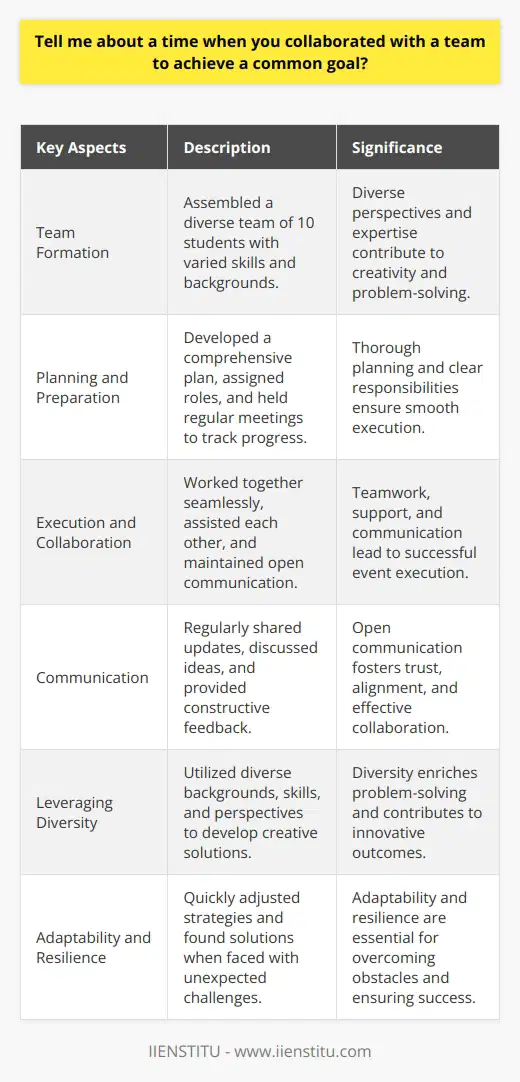
What strategies have you used to overcome challenges while working in a team?
Effective teamwork is crucial for success in various settings, but it often comes with challenges. One strategy I have used to overcome obstacles while working in a team is open communication. I make sure to express my thoughts and concerns clearly and listen actively to my teammates' perspectives. This helps prevent misunderstandings and fosters a collaborative environment.
Establishing Clear Roles and Responsibilities
Another approach I employ is establishing clear roles and responsibilities within the team. By defining each member's tasks and expectations, we can work more efficiently and avoid duplication of efforts. I also take the initiative to volunteer for tasks that align with my strengths and expertise, contributing to the team's overall success.
Embracing Diversity and Inclusivity
Working with diverse teammates can present challenges due to different backgrounds and perspectives. To overcome this, I actively embrace diversity and inclusivity. I strive to create an environment where every team member feels valued and respected. By leveraging our unique strengths and experiences, we can generate innovative ideas and solve problems more effectively.
Conflict Resolution and Compromise
Conflicts are inevitable in teamwork, but how we handle them determines our success. When faced with disagreements, I approach the situation with an open mind and a willingness to compromise. I listen to differing viewpoints, acknowledge valid concerns, and work towards finding a mutually beneficial solution. By focusing on common goals and maintaining a respectful dialogue, we can resolve conflicts constructively.
Adaptability and Flexibility
In dynamic team environments, adaptability is key. I remain flexible and open to change, adjusting my approach as needed. When faced with unexpected challenges or shifting priorities, I quickly assess the situation and adapt my strategies accordingly. By being agile and responsive, I can contribute to the team's resilience and success.
Continuous Learning and Improvement
I view challenges as opportunities for growth and learning. After each project or milestone, I engage in self-reflection and seek feedback from my teammates. By identifying areas for improvement and implementing the lessons learned, I continuously enhance my teamwork skills. I also proactively seek resources and training to expand my knowledge and capabilities, benefiting both myself and the team.
Celebrating Successes and Building Morale
Finally, I believe in the power of acknowledging and celebrating successes along the way. I make a point to recognize the contributions and achievements of my teammates, no matter how small. By expressing appreciation and creating a positive team atmosphere, we boost morale and motivation. Celebrating milestones and successes reinforces our sense of unity and encourages us to tackle future challenges together.
In conclusion, overcoming challenges in teamwork requires a combination of effective communication, clear roles, inclusivity, conflict resolution, adaptability, continuous learning, and celebration of successes. By employing these strategies, I have been able to navigate the complexities of teamwork and contribute to the overall success of the teams I have been a part of.

What are some effective strategies for building trust and fostering collaboration within a team?
Building trust and fostering collaboration within a team is crucial for achieving common goals and ensuring success. Effective strategies for building trust include open and honest communication, consistent behavior, and demonstrating reliability. Team members should communicate frequently, sharing information, ideas, and concerns openly and transparently. Consistency in words and actions helps establish credibility and reliability, allowing team members to depend on each other. Delivering on commitments and following through on promises further reinforces trust among team members.
Encouraging Active Participation and Valuing Contributions
Fostering collaboration requires creating an environment where every team member feels valued and encouraged to participate actively. Leaders should promote a culture of inclusivity, ensuring that all opinions and ideas are heard and considered. Recognizing and acknowledging individual contributions helps team members feel appreciated and motivated to collaborate more effectively. Regular team meetings and brainstorming sessions provide opportunities for everyone to share their thoughts and contribute to decision-making processes.
Establishing Clear Roles and Responsibilities
Clearly defining roles and responsibilities is essential for effective collaboration within a team. Each team member should have a clear understanding of their specific tasks, expectations, and how their work contributes to the overall goals. This clarity helps avoid confusion, duplication of efforts, and potential conflicts. Regular check-ins and progress updates ensure that everyone stays on track and aligned with the team's objectives.
Promoting a Positive and Supportive Team Culture
A positive and supportive team culture is vital for building trust and fostering collaboration. Encouraging a friendly and respectful work environment, where team members feel comfortable sharing ideas and offering constructive feedback, is crucial. Celebrating successes, both individual and collective, helps boost morale and strengthens the sense of camaraderie within the team. Organizing team-building activities and social events can further enhance relationships and foster a collaborative spirit.
Resolving Conflicts Constructively
Conflicts are inevitable in any team, but how they are addressed can significantly impact trust and collaboration. Encouraging open and respectful communication during conflicts helps team members express their concerns and perspectives without fear of judgment or retribution. Focusing on finding solutions rather than assigning blame promotes a constructive approach to problem-solving. Involving team members in the conflict resolution process and seeking their input demonstrates trust and values their contributions.
Leading by Example
Leaders play a crucial role in building trust and fostering collaboration within a team. They should lead by example, demonstrating the behaviors and values they expect from team members. Being transparent, accountable, and supportive helps create a positive and collaborative team culture. Leaders should also be proactive in addressing issues, providing guidance and support when needed, and recognizing the efforts and achievements of team members.
Building trust and fostering collaboration within a team requires ongoing effort and commitment from all members. By implementing effective strategies such as open communication, clear roles and responsibilities, a positive team culture, constructive conflict resolution, and leading by example, teams can create an environment where trust thrives and collaboration flourishes. Investing in building strong relationships and promoting a collaborative mindset ultimately leads to improved performance, innovation, and success for the team as a whole.
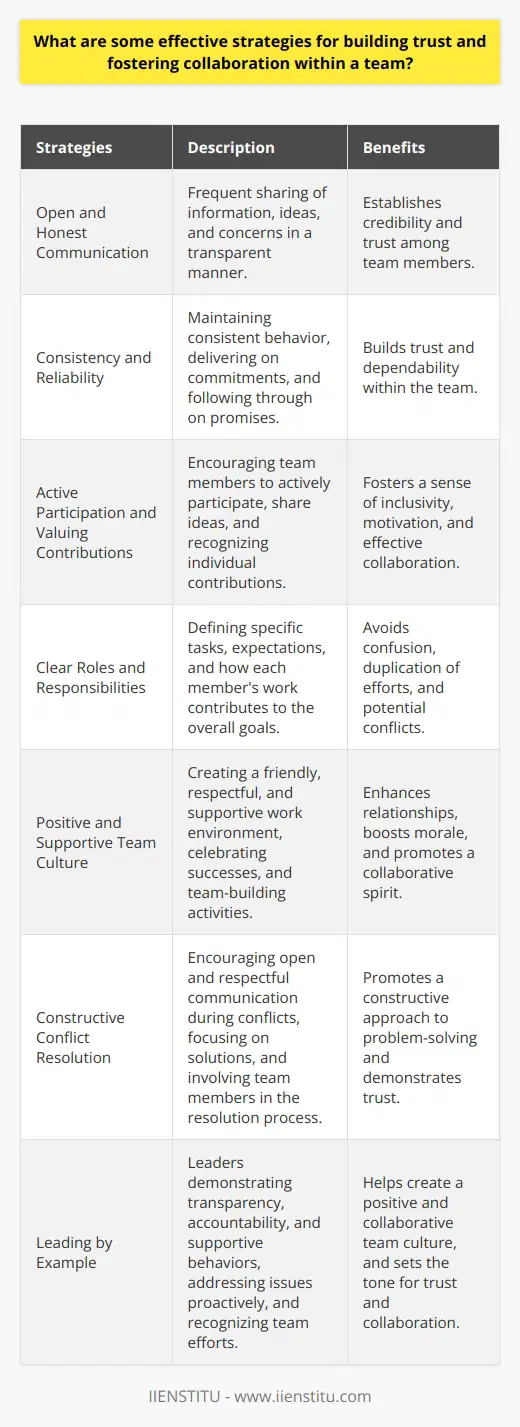
How can conflicts be resolved in a way that maintains team cohesion and productivity?
Resolving conflicts in a team setting requires a proactive approach that focuses on open communication and collaboration. Leaders must create an environment where team members feel comfortable expressing their concerns and ideas. Encouraging active listening and empathy among team members can foster understanding and respect. When conflicts arise, it's essential to address them promptly and objectively, separating the issue from the individuals involved.
Identify the Root Cause
To effectively resolve conflicts, teams must identify the underlying reasons behind the disagreement. Leaders should facilitate open discussions where each team member can share their perspective without fear of judgment. Asking questions and gathering information from all parties involved can help pinpoint the source of the conflict. Once the root cause is identified, the team can work together to find a solution that addresses everyone's concerns.
Focus on Common Goals
Reminding team members of their shared objectives can help shift the focus from individual differences to collective success. Leaders should emphasize the importance of working together to achieve the team's goals. Encouraging team members to find common ground and align their efforts towards a unified purpose can reduce tension and promote collaboration. When everyone is working towards the same end, conflicts become less significant, and solutions become more attainable.
Encourage Compromise and Collaboration
Finding a resolution that satisfies all parties involved often requires compromise. Leaders should encourage team members to be open to alternative viewpoints and willing to make concessions. Collaborative problem-solving techniques, such as brainstorming sessions, can help generate creative solutions that address everyone's needs. By working together to find a mutually beneficial outcome, team members can strengthen their relationships and improve their ability to handle future conflicts.
Provide Conflict Resolution Training
Investing in conflict resolution training can equip team members with the skills and tools they need to handle disagreements effectively. Teaching active listening, empathy, and assertive communication can help team members express their thoughts and feelings in a constructive manner. Providing guidance on how to approach conflicts objectively and find win-win solutions can foster a culture of collaboration and understanding within the team.
Monitor and Follow Up
Once a conflict has been resolved, leaders must monitor the situation to ensure that the solution is implemented effectively. Following up with team members to gather feedback and assess the impact of the resolution can help identify any lingering issues or concerns. Regularly checking in with the team can also prevent future conflicts by addressing potential problems before they escalate.
Celebrate Success
Acknowledging the team's success in resolving conflicts and maintaining cohesion can reinforce positive behavior and encourage future collaboration. Celebrating milestones and achievements can boost morale and remind team members of the importance of working together towards a common goal. Recognizing individual contributions to conflict resolution can also motivate team members to continue investing in their relationships and communication skills.
By adopting a proactive and collaborative approach to conflict resolution, teams can maintain cohesion and productivity. Encouraging open communication, focusing on common goals, and providing the necessary tools and training can help teams navigate disagreements and emerge stronger and more united. With effective conflict resolution strategies in place, teams can overcome challenges and achieve their objectives in a positive and supportive environment.
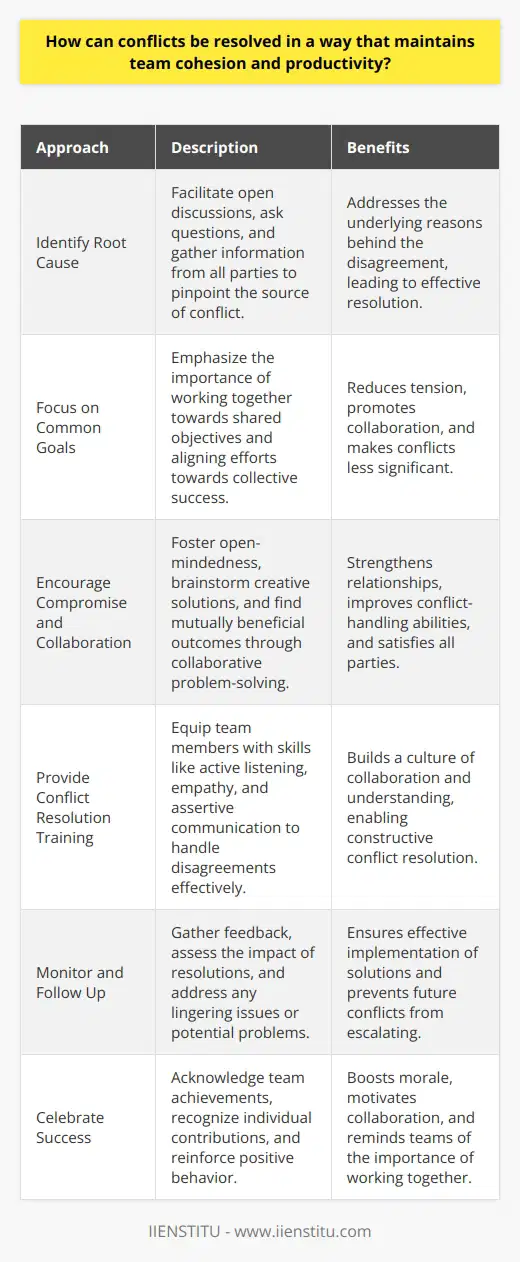
What role does communication play in ensuring successful teamwork, and how can it be improved?
Communication plays a crucial role in ensuring successful teamwork by facilitating collaboration, coordination, and shared understanding among team members. Effective communication enables team members to express their ideas, opinions, and concerns clearly and concisely. It also allows them to listen actively to others, fostering an environment of mutual respect and trust. When team members communicate openly and transparently, they can identify and resolve conflicts more easily, leading to better problem-solving and decision-making.
Strategies for Improving Communication in Teams
Establish Clear Communication Channels
Teams should establish clear communication channels that everyone can access and use effectively. This may include regular team meetings, email updates, instant messaging platforms, or project management tools. By having designated channels for communication, team members can stay informed and engaged, reducing the likelihood of misunderstandings or missed information.
Encourage Active Listening
Active listening is a critical component of effective communication in teams. Team members should practice giving their full attention to the speaker, asking clarifying questions, and providing constructive feedback. By actively listening to one another, team members can gain a deeper understanding of each other's perspectives and ideas, leading to more productive conversations and collaborations.
Provide Training on Communication Skills
Organizations can invest in training programs to help team members develop and refine their communication skills. These programs can cover topics such as active listening, assertive communication, conflict resolution, and giving and receiving feedback. By equipping team members with the tools and techniques to communicate effectively, organizations can foster a culture of open and transparent communication.
Foster a Psychologically Safe Environment
Psychological safety is essential for effective communication in teams. When team members feel safe to express their thoughts and ideas without fear of judgment or retribution, they are more likely to engage in open and honest communication. Leaders can foster psychological safety by modeling vulnerability, encouraging diverse perspectives, and celebrating failures as opportunities for learning and growth.
Regularly Assess and Adjust Communication Practices
Teams should regularly assess their communication practices and make adjustments as needed. This may involve soliciting feedback from team members, conducting communication audits, or implementing new tools and technologies to support effective communication. By continuously evaluating and improving communication practices, teams can ensure that they are operating at their highest level of effectiveness.
In conclusion, communication is the foundation of successful teamwork. By establishing clear communication channels, encouraging active listening, providing training on communication skills, fostering a psychologically safe environment, and regularly assessing and adjusting communication practices, teams can improve their communication and achieve better outcomes.
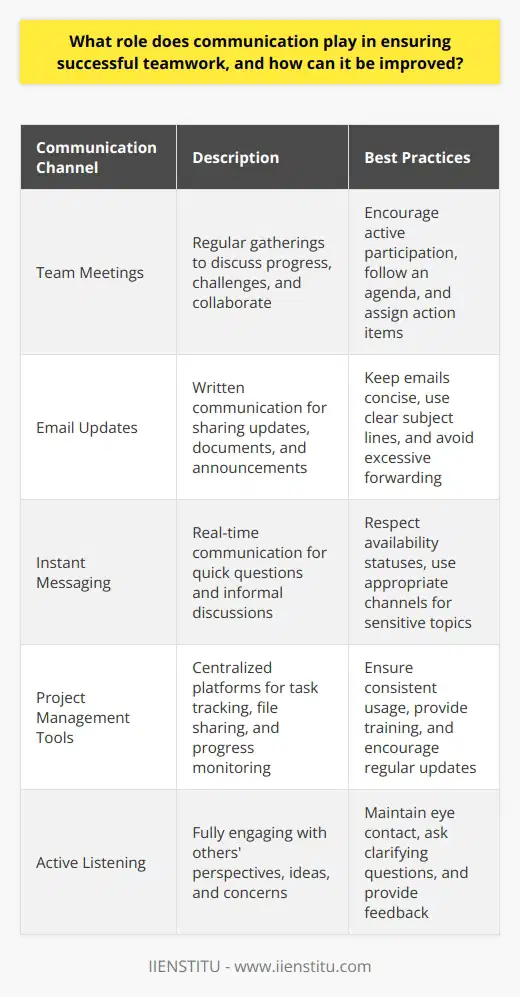
What strategies do you employ to foster a cohesive and collaborative team environment?
Fostering a cohesive and collaborative team environment is essential for achieving organizational goals and success. Several strategies can be employed to create a positive and productive team atmosphere.
Establish Clear Communication Channels
Effective communication is the foundation of a cohesive team. Encourage open and transparent communication among team members. Regularly schedule team meetings to discuss projects, share updates, and address any concerns. Utilize collaboration tools like instant messaging and project management software to facilitate seamless communication.
Encourage Active Listening
Active listening is crucial for understanding team members' perspectives and ideas. Encourage team members to listen attentively to one another. Create an environment where everyone feels heard and valued. Foster a culture of respect and empathy within the team.
Define Roles and Responsibilities
Clearly define each team member's roles and responsibilities to avoid confusion and overlap. Ensure that everyone understands their tasks and how they contribute to the team's overall objectives. Regularly review and update these roles as needed to maintain clarity and efficiency.
Set Shared Goals and Expectations
Establish shared goals and expectations for the team. Collaborate with team members to define objectives and timelines. Ensure that everyone is aligned and committed to achieving these goals. Regularly track progress and celebrate milestones to maintain motivation and unity.
Foster Trust and Psychological Safety
Trust is the bedrock of a cohesive team. Encourage open and honest communication without fear of judgment or retribution. Create a psychologically safe environment where team members feel comfortable expressing their thoughts and ideas. Lead by example, demonstrating vulnerability and admitting mistakes to build trust.
Encourage Collaboration and Idea Sharing
Promote a collaborative mindset within the team. Encourage team members to share their ideas and perspectives openly. Foster brainstorming sessions and cross-functional collaboration to generate innovative solutions. Recognize and acknowledge the contributions of each team member to reinforce a sense of belonging.
Provide Learning and Development Opportunities
Invest in the growth and development of your team members. Offer training, workshops, and mentoring programs to enhance their skills and knowledge. Encourage continuous learning and provide resources for professional development. Foster a culture of learning and growth within the team.
Celebrate Successes and Milestones
Recognize and celebrate the team's successes and milestones. Acknowledge individual and collective achievements through verbal praise, rewards, or team celebrations. Celebrating successes fosters a positive team spirit and reinforces the value of collaboration.
Resolve Conflicts Constructively
Conflicts are inevitable in any team environment. Establish a framework for resolving conflicts constructively and respectfully. Encourage open communication and active listening to understand different perspectives. Facilitate discussions to find mutually beneficial solutions and maintain a harmonious team dynamic.
By implementing these strategies, leaders can foster a cohesive and collaborative team environment that drives productivity, innovation, and organizational success. Remember, building a strong team takes time, effort, and consistent nurturing.

How do you handle conflicts or disagreements among team members?
Handling conflicts or disagreements among team members is a crucial skill for maintaining a productive and harmonious work environment. The first step in resolving conflicts is to identify the root cause of the issue. This may involve actively listening to each team member's perspective and concerns. It is essential to create a safe and open space where everyone feels heard and respected.
Encourage Open Communication
Encouraging open and honest communication among team members is vital for preventing and resolving conflicts. Regularly check in with team members and provide opportunities for them to express their thoughts and feelings. Foster a culture of transparency and actively seek feedback from all team members. By promoting open dialogue, misunderstandings and tensions can be addressed before they escalate into full-blown conflicts.
Mediate and Facilitate Resolution
When conflicts arise, it is important to act as a mediator and facilitate a resolution process. Bring the involved parties together and encourage them to express their viewpoints calmly and respectfully. Help them identify common ground and explore potential solutions that satisfy everyone's needs. Guide the conversation towards finding a mutually beneficial outcome, focusing on the issues rather than personal attacks.
Establish Clear Roles and Responsibilities
Clearly defining roles and responsibilities within the team can help prevent conflicts arising from ambiguity or overlapping duties. Ensure that each team member understands their specific tasks, deadlines, and expectations. Regularly review and update these roles as needed to maintain clarity and avoid confusion. When everyone knows their part in the team's success, it reduces the likelihood of conflicts stemming from misunderstandings or territorial disputes.
Foster a Collaborative Environment
Cultivate a team culture that values collaboration, respect, and mutual support. Encourage team members to work together towards common goals and celebrate shared successes. Promote a sense of unity and emphasize the importance of teamwork in achieving objectives. When team members feel they are part of a supportive and collaborative environment, they are more likely to approach conflicts with a problem-solving mindset rather than an adversarial one.
Provide Conflict Resolution Training
Investing in conflict resolution training for team members can equip them with the skills and strategies needed to handle disagreements effectively. Workshops or seminars on active listening, assertive communication, and problem-solving techniques can empower team members to navigate conflicts constructively. By providing these tools and resources, you create a team that is better prepared to address and resolve conflicts independently.
Remember, conflicts are a natural part of any team dynamic, but how they are handled can make all the difference. By fostering open communication, mediating resolutions, establishing clear roles, promoting collaboration, and providing conflict resolution training, you can create a team that is resilient and equipped to handle disagreements in a positive and productive manner.
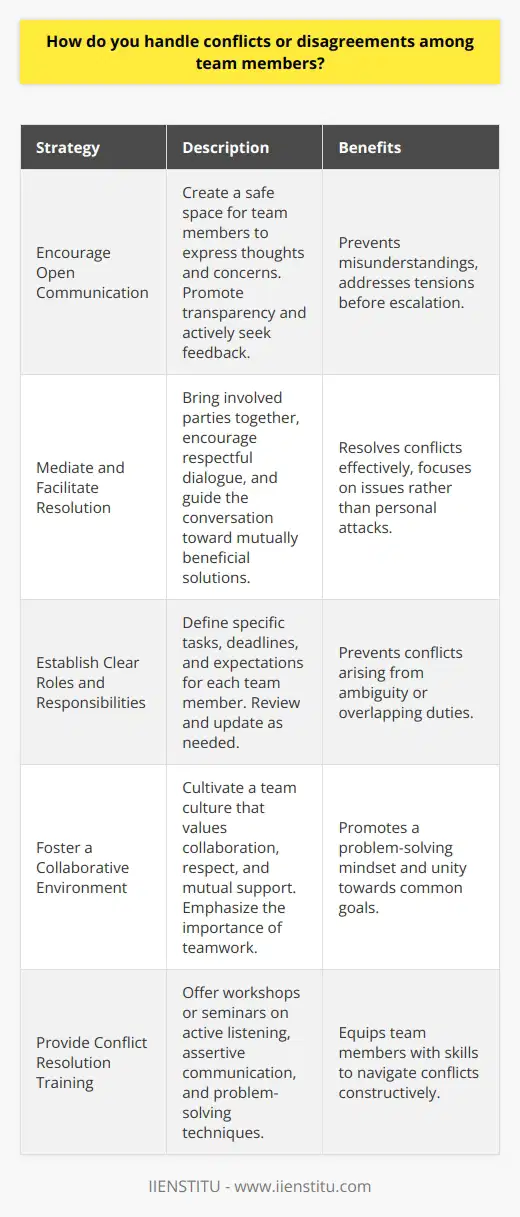
What methods do you use to motivate and inspire your team to achieve their goals?
Effective team motivation and inspiration are essential for achieving goals and fostering a positive work environment. Several methods can be employed to motivate and inspire team members. One key approach is to set clear, achievable goals that align with the team's strengths and capabilities. By communicating these goals effectively and providing regular feedback, team members can stay focused and engaged.
Another important method is to recognize and reward individual and team accomplishments. Acknowledging the efforts and successes of team members helps to boost morale and encourages continued high performance. This can be done through verbal praise, written acknowledgments, or even small rewards like gift cards or extra time off.
Fostering a Positive Work Environment
Creating a positive work environment is crucial for team motivation and inspiration. This can be achieved by promoting open communication, encouraging collaboration, and fostering a sense of trust and respect among team members. Regular team-building activities and opportunities for social interaction can also help to strengthen relationships and improve overall team dynamics.
Providing Opportunities for Growth and Development
Offering opportunities for growth and development is another effective way to motivate and inspire team members. This can include training programs, workshops, or mentorship opportunities that help team members acquire new skills and knowledge. By investing in the personal and professional development of team members, leaders demonstrate their commitment to the team's success and help to create a culture of continuous learning and improvement.
Leading by Example
Leading by example is a powerful way to motivate and inspire team members. When leaders demonstrate the behaviors and attitudes they expect from their team, it sets a positive tone and encourages others to follow suit. This can include maintaining a positive attitude, showing dedication and hard work, and being open to feedback and new ideas.
Encouraging Autonomy and Creativity
Allowing team members to have autonomy and encouraging creativity can also be highly motivating. When team members feel trusted to make decisions and contribute ideas, they are more likely to be engaged and invested in their work. Leaders can foster this by providing opportunities for team members to take on new challenges, share their ideas, and have input into decision-making processes.
Celebrating Milestones and Successes
Celebrating milestones and successes is an important way to keep team members motivated and inspired. Whether it's reaching a project goal, achieving a sales target, or receiving positive feedback from a client, taking the time to acknowledge and celebrate these accomplishments helps to reinforce the team's hard work and dedication.
Providing Regular Feedback and Support
Finally, providing regular feedback and support is essential for maintaining team motivation and inspiration. This includes offering constructive criticism when necessary, as well as praise and encouragement for a job well done. By being available to answer questions, provide guidance, and offer support when needed, leaders can help team members feel valued and supported in their roles.

What are some examples of how you have demonstrated teamwork in your previous roles?
Teamwork is a crucial skill in various professional settings, and I have demonstrated it throughout my previous roles. One notable example of my teamwork abilities was during my time as a marketing coordinator at XYZ Company. Our team was tasked with launching a new product campaign within a tight deadline, which required close collaboration among team members.
Collaborating on a Product Launch
To ensure the successful launch of the product, I actively participated in team meetings and brainstorming sessions. I listened attentively to my colleagues' ideas and provided constructive feedback to help refine our strategies. By maintaining open communication channels, we were able to identify potential challenges and develop effective solutions together.
Delegating Tasks and Responsibilities
As the project progressed, I took the initiative to delegate tasks based on each team member's strengths and expertise. I recognized that by leveraging our individual skills, we could work more efficiently and achieve better results. I also made sure to provide clear instructions and guidelines to ensure everyone understood their responsibilities and deadlines.
Supporting and Motivating Team Members
Throughout the campaign, I made a conscious effort to support and motivate my team members. I offered assistance when needed and provided encouragement during challenging times. I also made sure to acknowledge and celebrate our successes along the way, fostering a positive and collaborative team spirit.
Resolving Conflicts and Finding Solutions
Inevitably, conflicts arose during the project due to differing opinions and approaches. However, I remained calm and professional, actively listening to all perspectives and facilitating open discussions. By focusing on finding common ground and compromise, we were able to resolve disagreements and maintain a cohesive team dynamic.
Adapting to Remote Teamwork
In my most recent role at ABC Agency, I had to adapt to a remote work environment due to the pandemic. Despite the challenges of virtual collaboration, I made sure to stay connected with my team through regular video conferences and instant messaging. I also took the initiative to organize virtual team-building activities to maintain morale and foster a sense of camaraderie.
Collaborating Across Departments
In addition to working closely with my immediate team, I also collaborated with colleagues from other departments. I understood the importance of breaking down silos and fostering cross-functional teamwork. By establishing strong relationships and maintaining clear communication, we were able to seamlessly coordinate our efforts and achieve our shared goals.
Continuous Learning and Improvement
I believe that effective teamwork requires a willingness to learn and grow. I actively sought feedback from my team members and supervisors to identify areas for personal and professional development. I also encouraged my colleagues to share their knowledge and insights, creating an environment of continuous learning and improvement.
In summary, my previous experiences have allowed me to demonstrate strong teamwork skills in various contexts. From collaborating on product launches to adapting to remote work, I have consistently contributed to positive team dynamics and successful project outcomes. I am confident that these experiences have prepared me to be a valuable team player in future roles.
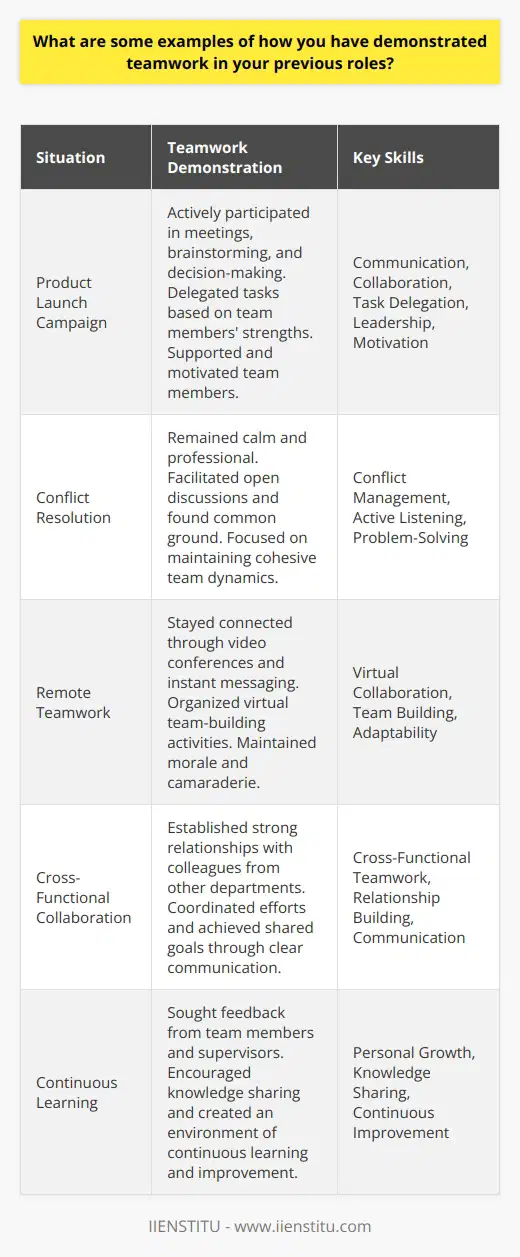
How do you handle conflicts or disagreements within a team?
Handling conflicts or disagreements within a team is crucial for maintaining productivity and a positive work environment. The first step in resolving conflicts is to identify the root cause of the issue. This may involve open communication with team members to understand their perspectives and concerns. Active listening is essential during this process, as it allows each person to feel heard and validated.
Encourage Open Communication
Encouraging open communication among team members is vital for preventing and resolving conflicts. Create a safe space where individuals feel comfortable expressing their thoughts and feelings without fear of judgment or retribution. Regularly schedule team meetings to discuss any issues or concerns and brainstorm solutions together.
Practice Active Listening
Active listening is a key component of effective communication and conflict resolution. When team members express their opinions or concerns, give them your full attention. Avoid interrupting or forming responses in your mind while they are speaking. Instead, focus on understanding their perspective and asking clarifying questions when necessary.
Find Common Ground
When conflicts arise, it's essential to find common ground among team members. Identify areas of agreement and shared goals, and use these as a foundation for problem-solving. Encourage team members to focus on the issues at hand rather than personal attacks or blame.
Brainstorm Solutions
Once the root cause of the conflict has been identified, and common ground has been established, brainstorm potential solutions as a team. Encourage all members to contribute ideas and consider each option's pros and cons. Aim for a win-win solution that addresses everyone's concerns and benefits the team as a whole.
Implement and Monitor Solutions
After agreeing on a solution, create a plan for implementation and monitoring progress. Assign responsibilities and set clear expectations for each team member. Regularly check in with the team to ensure that the solution is working effectively and make adjustments as needed.
Lead by Example
As a team leader or manager, it's crucial to lead by example when it comes to handling conflicts. Model active listening, empathy, and a solutions-oriented approach. Encourage team members to do the same and create a culture of open communication and collaboration.
Seek Outside Help When Necessary
In some cases, conflicts may be too complex or emotionally charged to resolve internally. Don't hesitate to seek outside help from a mediator or professional coach if needed. They can provide an objective perspective and facilitate productive conversations to help the team move forward.
By following these strategies, teams can effectively handle conflicts and disagreements, leading to a more harmonious and productive work environment. Remember that conflicts are a natural part of working with others, and by approaching them with empathy, open-mindedness, and a focus on solutions, teams can emerge stronger and more united.
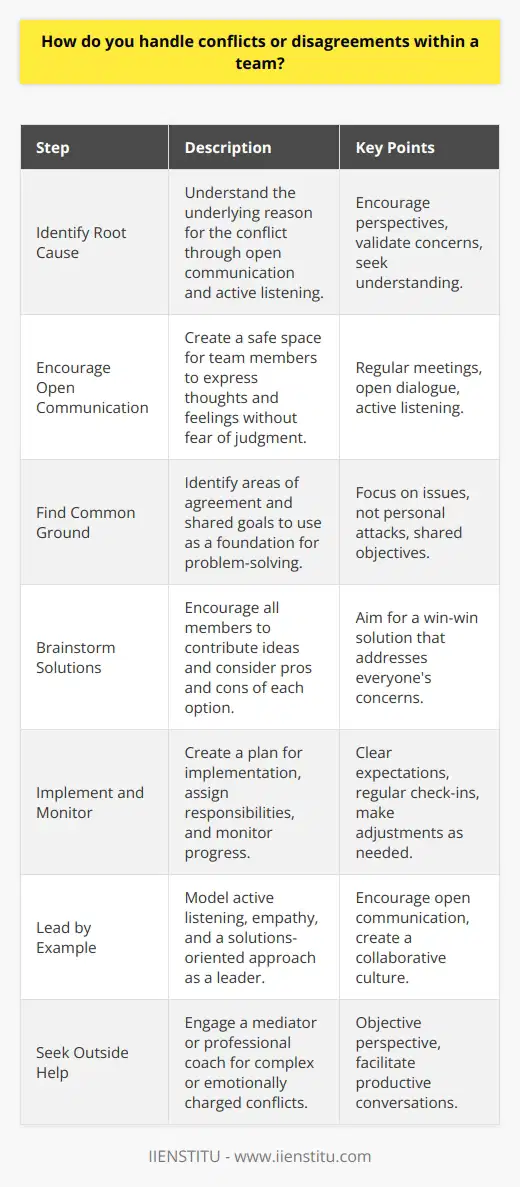
Can you describe a time when you had to collaborate with a difficult team member and how you approached the situation?
Collaborating with difficult team members is an inevitable challenge in any professional setting. In my experience, I once had to work closely with a colleague who consistently demonstrated a negative attitude and resistant behavior towards our project goals. Initially, this created a significant obstacle in our ability to make progress and maintain a productive working environment.
To approach this situation effectively, I first sought to understand the underlying reasons behind my team member's difficult behavior. Through open and honest communication, I discovered that they were feeling overwhelmed by the project's demands and were struggling to keep up with the pace of our work. By actively listening to their concerns and showing empathy towards their situation, I was able to establish a more positive rapport and build trust with this individual.
Establishing Clear Expectations and Roles
Next, I worked with my team member to clearly define our project expectations and roles. By breaking down our goals into smaller, manageable tasks and setting realistic deadlines, we were able to create a more structured and organized approach to our work. This helped to alleviate some of the pressure and uncertainty that my team member was experiencing, and allowed us to work more efficiently together.
Encouraging Open Communication and Feedback
Throughout the project, I made a conscious effort to maintain open lines of communication and encourage regular feedback from all team members. By creating a safe and inclusive environment where everyone felt heard and valued, we were able to have more productive conversations and work through any challenges or disagreements in a constructive manner.
Focusing on Strengths and Contributions
I also made a point to recognize and celebrate my team member's strengths and contributions to the project. By acknowledging their skills and expertise, and providing opportunities for them to take on leadership roles in areas where they excelled, I was able to boost their confidence and motivation. This helped to create a more positive and collaborative team dynamic, and ultimately led to the successful completion of our project.
Lessons Learned
Through this experience, I learned the importance of empathy, communication, and adaptability when working with difficult team members. By taking the time to understand their perspective, establishing clear expectations and roles, encouraging open feedback, and focusing on their strengths, I was able to transform a challenging situation into a positive and productive one. These lessons have served me well in subsequent team projects and have helped me to become a more effective and resilient collaborator.
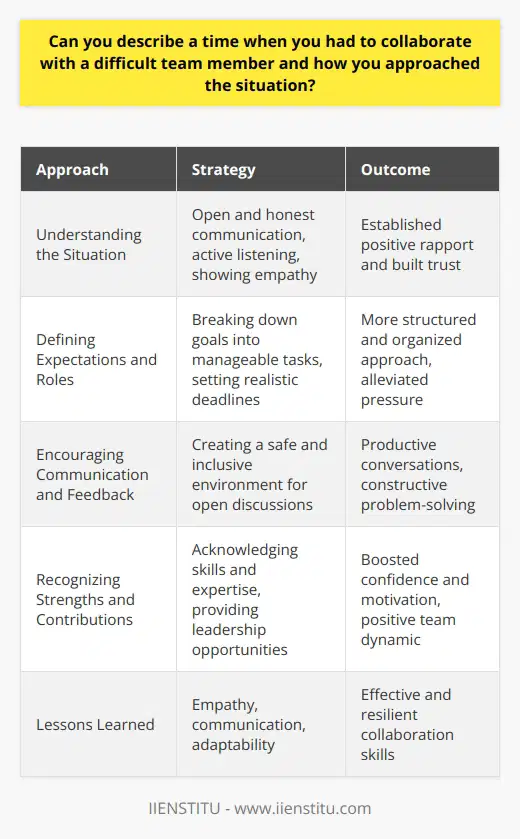
What strategies do you employ to foster effective collaboration among team members?
Fostering effective collaboration among team members is crucial for achieving common goals and delivering high-quality results. Implementing the right strategies can significantly enhance teamwork and productivity. This blog post explores various techniques to promote collaboration within teams.
Establishing Clear Communication Channels
Open and transparent communication is the foundation of effective collaboration. Encourage team members to share ideas, opinions, and concerns regularly. Utilize communication tools like instant messaging, video conferencing, and project management software to facilitate seamless interaction among team members, regardless of their location.
Conducting Regular Team Meetings
Schedule regular team meetings to discuss project progress, share updates, and address any challenges or roadblocks. These meetings provide an opportunity for team members to align their efforts, clarify responsibilities, and make informed decisions collectively.
Defining Roles and Responsibilities
Clearly define the roles and responsibilities of each team member. Ensure that everyone understands their specific tasks and how they contribute to the overall project objectives. This clarity helps prevent confusion, duplication of efforts, and potential conflicts.
Creating a RACI Matrix
Develop a RACI (Responsible, Accountable, Consulted, Informed) matrix to outline the involvement of each team member in various project activities. This matrix helps establish accountability and ensures that the right people are engaged at the appropriate stages of the project.
Promoting a Collaborative Culture
Foster a collaborative culture within the team by encouraging open communication, active listening, and mutual respect. Create an environment where team members feel comfortable sharing their ideas and opinions without fear of judgment or criticism. Recognize and celebrate collaborative efforts to reinforce positive behavior.
Organizing Team-Building Activities
Engage in team-building activities to strengthen relationships and build trust among team members. These activities can range from informal gatherings to structured workshops focusing on problem-solving, communication, or creative thinking exercises.
Leveraging Collaboration Tools
Utilize collaboration tools and platforms to streamline communication, share files, and track progress. Tools like Google Drive, Trello, Asana, or Slack enable team members to work together seamlessly, regardless of their physical location. These tools also provide visibility into project milestones and deliverables.
Providing Training on Collaboration Tools
Offer training sessions to familiarize team members with the collaboration tools being used. Ensure that everyone understands how to effectively utilize these tools to maximize their potential and enhance collaboration.
Encouraging Knowledge Sharing
Promote a culture of knowledge sharing within the team. Encourage team members to share their expertise, insights, and best practices with one another. Establish knowledge repositories or wikis where team members can document and access valuable information easily.
Implementing Peer-to-Peer Learning
Foster peer-to-peer learning opportunities where team members can learn from each other's experiences and skills. Pair experienced team members with less experienced ones to facilitate mentoring and knowledge transfer.
By implementing these strategies, you can create an environment that nurtures effective collaboration among team members. Remember that collaboration is an ongoing process that requires consistent effort, open communication, and a willingness to adapt and improve continuously.

How do you handle conflicts or disagreements that may arise within a team?
Handling conflicts or disagreements within a team is crucial for maintaining productivity and a positive work environment. The first step in resolving conflicts is to identify the root cause of the issue. This may involve open and honest communication with team members to understand their perspectives and concerns. Active listening is essential during this process, as it allows each person to feel heard and validated.
Encourage Open Communication
Encouraging open communication among team members can help prevent conflicts from escalating. Create a safe space where individuals feel comfortable expressing their thoughts and feelings without fear of judgment or retribution. Regular team meetings or check-ins can provide opportunities for team members to voice their concerns and work together to find solutions.
Practice Active Listening
Active listening is a key component of effective communication and conflict resolution. When a team member expresses a concern or disagreement, focus on understanding their perspective before responding. Ask clarifying questions and paraphrase their statements to ensure you have accurately understood their point of view. This helps to build trust and rapport within the team.
Find Common Ground
When conflicts arise, it is important to find common ground among team members. Identify areas of agreement and shared goals, and use these as a foundation for problem-solving. Encourage team members to focus on the issues at hand rather than personal differences or past grievances. By emphasizing shared objectives, the team can work together to find mutually beneficial solutions.
Brainstorm Solutions
Once the root cause of the conflict has been identified and common ground established, encourage the team to brainstorm potential solutions. Foster an environment where all ideas are welcome and considered, regardless of their source. Evaluate each solution based on its feasibility, effectiveness, and alignment with team goals. Collaborate to refine the most promising solutions and develop an action plan for implementation.
Implement and Monitor
After selecting a solution, assign roles and responsibilities to team members for implementation. Establish clear timelines and milestones to ensure progress is being made. Regularly monitor the effectiveness of the solution and make adjustments as needed. Celebrate successes along the way and acknowledge the contributions of each team member.
Seek Outside Mediation
In some cases, conflicts may be too complex or emotionally charged to resolve internally. When this occurs, seeking outside mediation can be beneficial. A neutral third party, such as a trained mediator or HR representative, can provide an objective perspective and facilitate productive conversations. They can help team members express their concerns in a constructive manner and guide them towards a resolution.
Learn from Conflicts
Finally, it is important to view conflicts as opportunities for growth and learning. After a conflict has been resolved, take time to reflect on the process and identify any lessons learned. Consider how similar conflicts can be prevented in the future and what strategies were most effective in resolving the issue. By treating conflicts as learning experiences, teams can continuously improve their communication, collaboration, and problem-solving skills.

Can you describe a time when you successfully contributed to a team project and what role did you play?
In my academic journey, I have had the opportunity to contribute to several team projects successfully. One notable experience was during a research project in my senior year of college. Our team was tasked with investigating the impact of social media on the mental health of adolescents. As a team member, I played a crucial role in data collection and analysis.
Collaboration and Planning
From the outset, our team recognized the importance of effective collaboration and planning. We held regular meetings to discuss our goals, assign responsibilities, and establish deadlines. I actively participated in these discussions, offering insights and suggestions to ensure the project's smooth progress. Together, we developed a comprehensive plan that outlined each member's tasks and the timeline for completion.
Data Collection
My primary responsibility was to collect data for the research project. I designed and distributed surveys to a diverse group of adolescents, ensuring a representative sample. I also conducted interviews with mental health professionals to gather expert opinions on the topic. Throughout the data collection process, I maintained open communication with my team members, providing regular updates and seeking their input when necessary.
Data Analysis
Once the data was collected, I took the lead in analyzing the results. I used statistical software to identify patterns and trends in the data. I also collaborated with my team members to interpret the findings and draw meaningful conclusions. We engaged in thoughtful discussions, considering various perspectives and ensuring that our analysis was thorough and unbiased.
Presentation and Report Writing
As the project neared completion, I contributed to the preparation of the final presentation and report. I worked closely with my team members to create engaging visual aids and a well-structured report that effectively communicated our findings. We rehearsed our presentation multiple times, providing constructive feedback to each other and refining our delivery.
Successful Outcome
Our team's dedication and collaborative efforts paid off. We delivered a compelling presentation that impressed our professors and peers. Our research findings provided valuable insights into the relationship between social media and adolescent mental health. The project not only earned us a high grade but also sparked meaningful discussions within the academic community.
Lessons Learned
Through this experience, I learned the importance of effective communication, delegation, and adaptability in a team setting. I discovered the value of leveraging each team member's strengths and expertise to achieve a common goal. Moreover, I realized the significance of active listening, constructive feedback, and a willingness to compromise when working collaboratively.
In conclusion, contributing to this team research project was a rewarding and educational experience. It highlighted the power of teamwork, effective planning, and dedication in achieving success. The skills and lessons I gained from this experience have proven invaluable in my subsequent academic and professional endeavors, equipping me with the tools to be a valuable team player and leader.
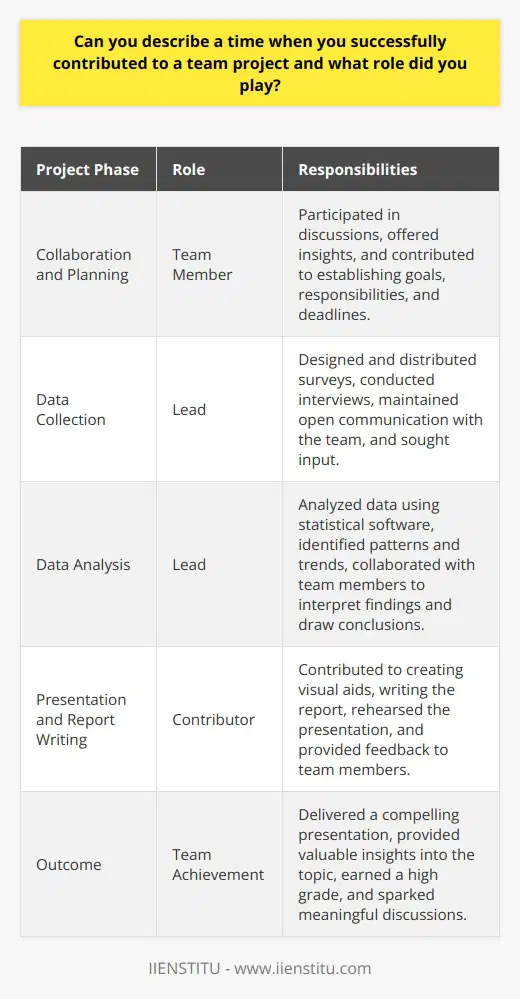
How do you typically contribute to team projects?
When participating in team projects, I strive to contribute in a variety of ways to ensure successful outcomes. I actively engage in the planning and brainstorming process, offering creative ideas and solutions to challenges. I take responsibility for specific tasks and deliverables, ensuring that my work is completed to a high standard and within the agreed-upon timeline.
Communication and Collaboration
Effective communication is crucial for successful teamwork. I maintain open lines of communication with my team members, keeping them informed of my progress and any potential roadblocks. I actively listen to others' ideas and perspectives, fostering a collaborative environment where everyone feels heard and valued. I provide constructive feedback and support to my teammates, helping to improve the overall quality of our work.
Problem-Solving and Adaptability
When faced with challenges or setbacks, I approach them with a problem-solving mindset. I analyze the situation, gather relevant information, and propose potential solutions. I am adaptable and flexible, willing to adjust my approach or take on additional responsibilities when necessary to ensure the project stays on track. I remain calm under pressure and help maintain a positive team dynamic, even in challenging circumstances.
Leveraging Strengths and Expertise
I identify and leverage my strengths and areas of expertise to make valuable contributions to the team. Whether it's utilizing my technical skills, research abilities, or creative talents, I find ways to apply my knowledge and experience to advance the project. I also recognize the strengths of my teammates and encourage them to contribute in areas where they excel, fostering a collaborative environment that maximizes everyone's potential.
Attention to Detail and Quality
I pay close attention to detail in my work, ensuring that deliverables are accurate, well-organized, and meet the required standards. I take pride in producing high-quality work and strive to exceed expectations. I review and proofread my contributions, making necessary revisions and seeking feedback from my teammates to continually improve the overall project quality.
Initiative and Proactivity
I take initiative and proactively seek opportunities to contribute to the team's success. I anticipate potential challenges or needs and take steps to address them before they become significant issues. I am self-motivated and willing to go the extra mile to ensure the project stays on track and meets its objectives. I also look for ways to enhance team processes, suggest improvements, and find efficiencies that can benefit the entire team.
By actively engaging in the project, communicating effectively, leveraging my strengths, and maintaining a focus on quality, I aim to be a valuable and reliable contributor to any team project. I believe that successful teamwork is built on a foundation of collaboration, adaptability, and a shared commitment to achieving common goals.
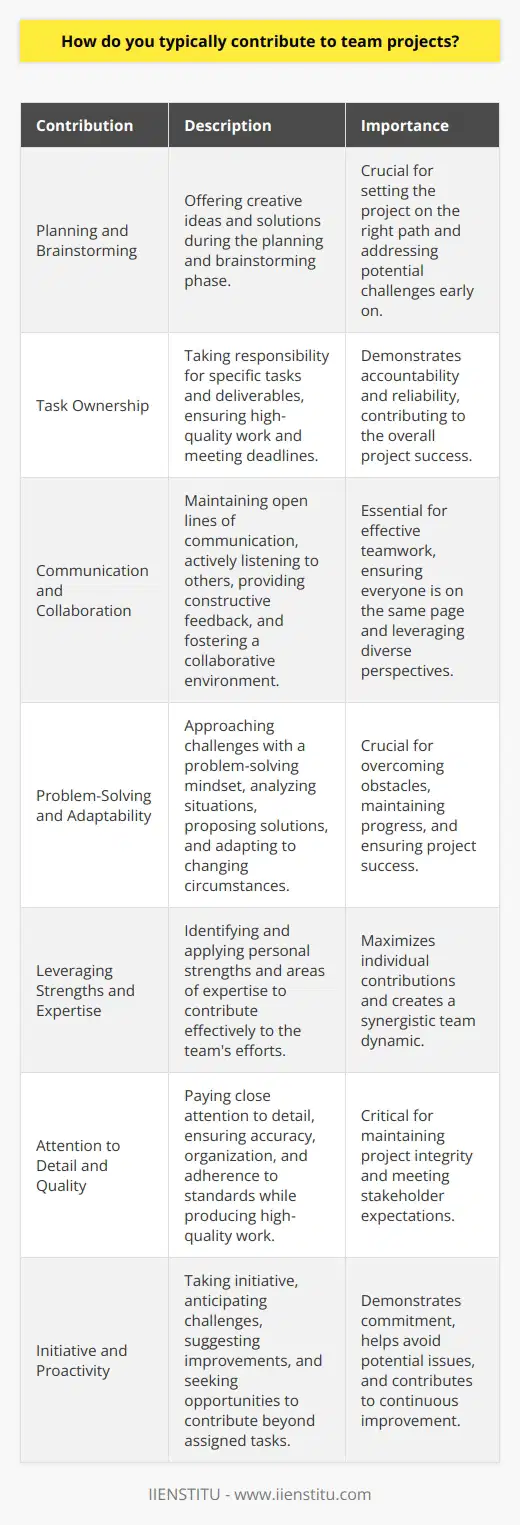
What strategies do you employ to foster effective collaboration among team members?
Fostering effective collaboration among team members is crucial for achieving project goals and enhancing overall productivity. To promote successful teamwork, I employ several strategies that encourage open communication, trust, and shared responsibility. These strategies include establishing clear roles and expectations, facilitating regular team meetings, and promoting a supportive and inclusive team culture.
Establishing Clear Roles and Expectations
One of the first steps in fostering effective collaboration is to ensure that each team member understands their specific role and responsibilities. By clearly defining individual contributions, team members can focus on their strengths and expertise, leading to more efficient task allocation and completion. Additionally, setting clear expectations for communication, deadlines, and quality of work helps maintain accountability and prevents misunderstandings.
Facilitating Regular Team Meetings
Regular team meetings play a vital role in promoting collaboration and keeping everyone informed and aligned. These meetings provide a platform for sharing updates, discussing challenges, and brainstorming solutions. I encourage active participation from all team members, ensuring that everyone has an opportunity to contribute their ideas and perspectives. By fostering open dialogue and active listening, team meetings help build trust and rapport among team members.
Promoting a Supportive and Inclusive Team Culture
Creating a supportive and inclusive team culture is essential for effective collaboration. I strive to cultivate an environment where team members feel valued, respected, and comfortable expressing their thoughts and opinions. Encouraging diversity of thought and embracing different perspectives leads to more innovative and well-rounded solutions. By actively promoting a positive team dynamic, I help foster a sense of belonging and shared purpose among team members.
Encouraging Knowledge Sharing and Continuous Learning
To further enhance collaboration, I encourage knowledge sharing and continuous learning within the team. By creating opportunities for team members to share their expertise and learn from one another, we can leverage the collective intelligence of the group. This can be achieved through initiatives such as cross-training, mentoring programs, and knowledge-sharing sessions. By fostering a culture of continuous learning, team members can expand their skills and adapt to new challenges more effectively.
Recognizing and Celebrating Achievements
Recognizing and celebrating team achievements is another important strategy for fostering collaboration. When team members feel appreciated and acknowledged for their contributions, they are more likely to remain motivated and engaged. I make a point to regularly highlight individual and team successes, whether through verbal praise, written acknowledgments, or small rewards. Celebrating milestones and accomplishments reinforces the value of teamwork and encourages continued collaboration.
By implementing these strategies consistently, I aim to create a collaborative environment where team members feel empowered, supported, and motivated to work together towards common goals. Effective collaboration is an ongoing process that requires commitment, communication, and a willingness to adapt and improve. By continuously refining these strategies and staying attuned to the needs of the team, I strive to foster a culture of collaboration that drives success and innovation.

Can you describe a time when you helped resolve a conflict within a team setting?
In an academic setting, resolving conflicts within a team is crucial for maintaining productivity and achieving goals. I once found myself in a situation where two team members were engaged in a heated disagreement over the direction of our research project. The conflict escalated, causing a breakdown in communication and threatening the progress of our work.
Recognizing the need for intervention, I took the initiative to mediate the conflict. I arranged a meeting with both team members and encouraged them to express their concerns and perspectives openly. By actively listening to each person and acknowledging their valid points, I helped create an atmosphere of understanding and respect.
Identifying Common Ground
During the mediation process, I focused on identifying the common ground between the conflicting parties. Despite their differences, both team members shared a commitment to the success of the project. By emphasizing this shared goal, I helped them recognize the importance of finding a mutually beneficial solution.
Brainstorming Solutions
To move the conversation forward, I facilitated a brainstorming session where both team members could propose potential solutions. We explored various approaches, considering the merits and drawbacks of each option. By encouraging open-mindedness and creativity, we generated a range of ideas that addressed the concerns of both parties.
Negotiating a Compromise
With a list of potential solutions, we worked together to negotiate a compromise. I encouraged each team member to make concessions and find a middle ground that would satisfy their individual needs while prioritizing the overall project's success. Through active listening and constructive feedback, we eventually reached a mutually agreeable solution.
Implementing the Solution
Once a compromise was reached, I helped the team develop an action plan to implement the agreed-upon solution. We clearly defined roles, responsibilities, and timelines to ensure a smooth execution. Regular check-ins were scheduled to monitor progress and address any potential issues that might arise.
The successful resolution of this conflict demonstrated the importance of effective communication, active listening, and a willingness to compromise. By taking a proactive approach and facilitating open dialogue, I helped the team navigate a challenging situation and emerge stronger and more united.
This experience taught me valuable lessons about conflict resolution within a team setting. It highlighted the significance of identifying common goals, exploring diverse perspectives, and finding mutually beneficial solutions. By applying these skills, teams can overcome conflicts, foster collaboration, and achieve their objectives more effectively.
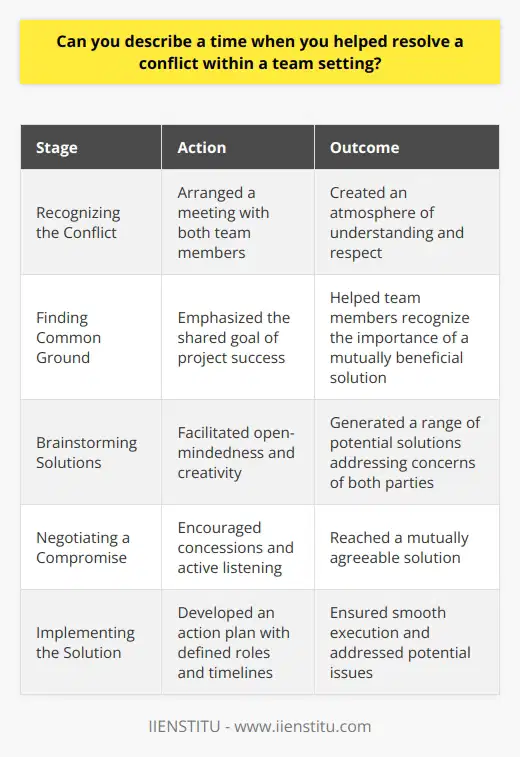
What specific team building activities have you participated in and what were their outcomes?
Team building activities are essential for fostering collaboration, communication, and trust among team members. Throughout my professional experience, I have participated in various team building exercises that have yielded positive outcomes. One notable activity was a scavenger hunt that required teams to work together to solve puzzles and complete challenges. This activity encouraged problem-solving skills, creativity, and effective communication within the team. As a result, team members developed a stronger bond and improved their ability to work collaboratively towards a common goal.
The Benefits of Obstacle Courses
Another effective team building activity I took part in was an obstacle course. This physical challenge required team members to support and encourage one another as they navigated through various obstacles. The activity emphasized the importance of trust, as team members had to rely on each other for support and guidance. Through this experience, team members learned to appreciate each other's strengths and weaknesses, leading to a more cohesive and supportive team dynamic.
Enhancing Communication Skills
Additionally, I have participated in communication-focused team building activities, such as role-playing exercises. These activities aimed to improve communication skills and help team members understand different perspectives. By engaging in simulated scenarios, team members learned to listen actively, express themselves clearly, and provide constructive feedback. As a result, the team experienced improved communication, reduced misunderstandings, and increased efficiency in their day-to-day interactions.
Strengthening Problem-Solving Abilities
Problem-solving activities have also been a valuable part of my team building experiences. In one activity, teams were presented with a complex problem and tasked with developing a solution within a limited timeframe. This exercise encouraged critical thinking, brainstorming, and collaboration. By working together to analyze the problem and generate ideas, team members enhanced their problem-solving abilities and learned to leverage each other's strengths.
Promoting Creativity and Innovation
Lastly, I have engaged in team building activities that promote creativity and innovation. One such activity involved teams creating a product or service concept and presenting it to the group. This exercise fostered out-of-the-box thinking, encouraged risk-taking, and celebrated unique ideas. By providing a platform for creative expression, the activity helped team members develop a growth mindset and embrace innovation in their work.
The Lasting Impact of Team Building
In conclusion, the team building activities I have participated in have had a significant impact on team dynamics and performance. From scavenger hunts and obstacle courses to communication exercises and problem-solving challenges, these activities have fostered collaboration, trust, and personal growth among team members. The outcomes of these experiences have been long-lasting, contributing to a positive work environment, increased productivity, and a shared sense of purpose within the team.

How have you contributed to fostering a positive and collaborative team environment?
Fostering a positive and collaborative team environment is crucial for the success of any organization. I have actively contributed to this by implementing various strategies and initiatives. These efforts have focused on promoting open communication, building trust, and encouraging a shared sense of purpose among team members.
Encouraging Open Communication
One of the key ways I have fostered a positive team environment is by encouraging open communication. I regularly initiate team meetings and one-on-one discussions to provide a platform for sharing ideas, concerns, and feedback. By actively listening to team members and valuing their input, I create an atmosphere where everyone feels heard and respected.
Moreover, I lead by example by being transparent and honest in my communication. I share relevant information, updates, and decisions with the team in a timely manner. This transparency builds trust and ensures that everyone is on the same page, working towards common goals.
Building Trust and Relationships
Building trust and strong relationships among team members is another essential aspect of fostering a positive environment. I make a conscious effort to get to know my team members on a personal level. I engage in informal conversations, show genuine interest in their well-being, and celebrate their achievements.
Additionally, I organize team-building activities and social events to strengthen bonds and promote camaraderie. These activities range from team lunches and off-site retreats to collaborative projects and skill-sharing sessions. By creating opportunities for team members to interact and collaborate in different settings, I facilitate the development of a cohesive and supportive team dynamic.
Promoting a Shared Sense of Purpose
To foster a collaborative team environment, it is crucial to promote a shared sense of purpose. I make sure that every team member understands the organization's mission, vision, and goals. I regularly communicate how their individual roles and contributions align with the bigger picture.
Furthermore, I involve team members in goal-setting and decision-making processes. By seeking their input and valuing their perspectives, I create a sense of ownership and engagement. When team members feel invested in the team's success, they are more likely to collaborate effectively and go the extra mile.
Recognizing and Appreciating Contributions
Recognizing and appreciating the contributions of team members is a powerful way to foster a positive environment. I make it a point to acknowledge and celebrate the successes and efforts of my team, both individually and collectively. Whether it's through verbal praise, written acknowledgments, or formal recognition programs, I ensure that team members feel valued and appreciated for their hard work.
Moreover, I encourage team members to recognize and appreciate each other's contributions. By promoting a culture of gratitude and mutual support, I create an environment where team members feel motivated and inspired to give their best.
Leading by Example
As a leader, I understand the importance of leading by example. I strive to embody the values and behaviors that I expect from my team. I demonstrate a positive attitude, a strong work ethic, and a willingness to collaborate and support others.
By being a role model, I set the tone for the team and inspire them to follow suit. I also remain approachable and available to provide guidance, mentorship, and support whenever needed. By being a reliable and supportive leader, I foster a positive and collaborative team environment.
Continuous Improvement and Feedback
Fostering a positive team environment is an ongoing process that requires continuous improvement and feedback. I regularly seek feedback from team members to understand their perspectives and identify areas for improvement. I encourage open and constructive feedback, both upward and peer-to-peer.
Based on the feedback received, I implement necessary changes and improvements to enhance the team's dynamics and effectiveness. By being receptive to feedback and actively working on areas of improvement, I demonstrate my commitment to creating a positive and collaborative team environment.
Conclusion
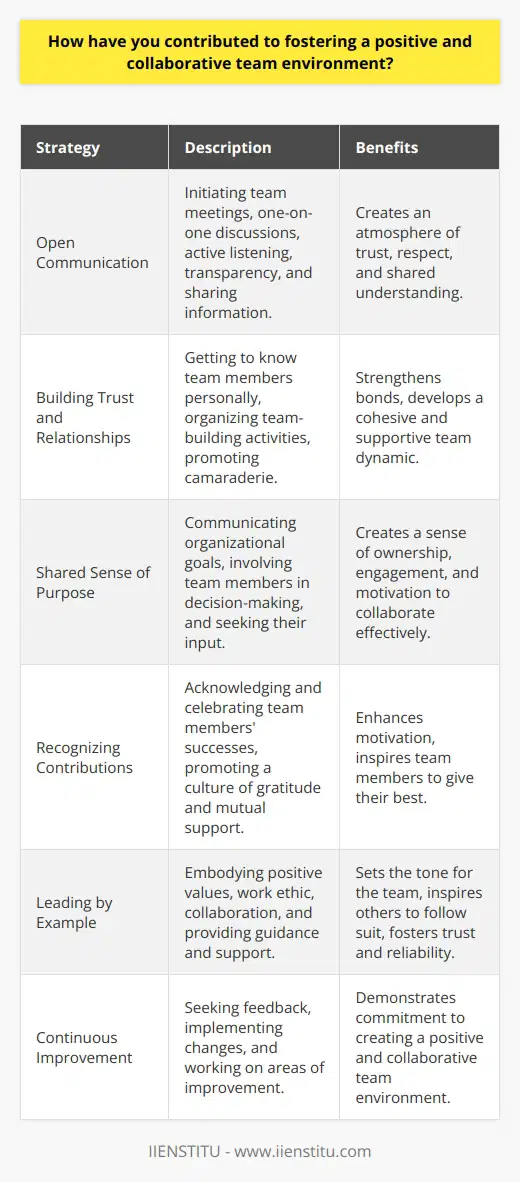
Can you describe a challenging team situation you faced and how you helped resolve it?
Effective teamwork is essential for success in any professional setting, but it can also present unique challenges. One particularly difficult situation I encountered involved a team project where two members had drastically different working styles and personalities, leading to constant conflicts and hindering progress. As the team leader, I recognized the need to intervene and find a resolution to ensure the project's success.
Identifying the Root Cause
To address the issue, I first sought to understand the underlying reasons behind the team members' conflicts. I conducted individual meetings with each team member, providing a safe space for them to express their concerns and perspectives. Through these discussions, I discovered that the root cause of their disagreements stemmed from a lack of clear communication and understanding of each other's working preferences.
Facilitating Open Communication
To bridge the communication gap, I organized a team meeting focused on fostering open dialogue and mutual understanding. I encouraged the team members to share their preferred working styles, strengths, and areas where they needed support. By creating an environment that promoted active listening and respectful exchange of ideas, the team members began to appreciate their differences and find common ground.
Establishing Clear Roles and Expectations
Next, I worked with the team to clarify roles and expectations for each member. We collaborated to create a detailed project plan that outlined individual responsibilities, deadlines, and deliverables. By ensuring that everyone had a clear understanding of their contributions to the project, we minimized ambiguity and potential misunderstandings that could lead to conflicts.
Promoting a Collaborative Mindset
To further strengthen the team's cohesion, I emphasized the importance of a collaborative mindset. I encouraged team members to offer support and assistance to one another, recognizing that each person's success was tied to the overall success of the project. We implemented regular check-ins and progress updates to maintain open lines of communication and address any issues promptly.
Celebrating Milestones and Successes
As the team began to work more harmoniously, I made sure to acknowledge and celebrate their progress and successes along the way. Recognizing the team's hard work and achievements helped boost morale and reinforce the value of effective collaboration. By fostering a positive and supportive team dynamic, we were able to overcome the initial challenges and deliver a successful project outcome.
Resolving team conflicts requires a proactive and empathetic approach from leadership. By actively listening, facilitating open communication, establishing clear expectations, and promoting a collaborative mindset, leaders can navigate challenging team situations and guide their teams towards success. The experience I gained from this particular situation has equipped me with valuable skills in conflict resolution and team management that I continue to apply in my professional endeavors.

How can you effectively collaborate with team members from diverse backgrounds?
Collaborating effectively with team members from diverse backgrounds requires a combination of open-mindedness, communication, and adaptability. To foster successful collaboration, it is essential to create an inclusive environment that values and respects diversity. This involves actively listening to each team member's perspectives and ideas, regardless of their background or cultural differences.
Embrace Cultural Differences
Embracing cultural differences is key to effective collaboration in diverse teams. Take the time to learn about your team members' cultural backgrounds, customs, and communication styles. This knowledge will help you navigate potential misunderstandings and build stronger relationships with your colleagues. Celebrate the unique perspectives and experiences that each team member brings to the table, as this diversity can lead to innovative solutions and improved problem-solving.
Promote Open Communication
Open communication is vital for successful collaboration in diverse teams. Encourage team members to share their thoughts, ideas, and concerns freely. Create a safe space where everyone feels comfortable expressing themselves without fear of judgment or criticism. Regularly check in with your colleagues to ensure that everyone is on the same page and that no one feels left out or unheard.
Practice Active Listening
Active listening is a critical skill for effective collaboration. When working with team members from diverse backgrounds, pay close attention to what they are saying and try to understand their perspectives. Avoid interrupting or making assumptions based on stereotypes or preconceived notions. Ask clarifying questions to ensure that you have a clear understanding of their ideas and concerns.
Be Adaptable and Flexible
Adaptability and flexibility are essential when collaborating with diverse team members. Be open to trying new approaches and adjusting your communication style to better suit your colleagues' needs. Recognize that what works for one team member may not work for another, and be willing to find common ground and compromise when necessary.
Foster Inclusivity and Respect
Creating an inclusive and respectful work environment is crucial for effective collaboration in diverse teams. Treat all team members with equal respect, regardless of their background, position, or experience level. Encourage everyone to contribute their ideas and opinions, and make sure that all voices are heard and valued. Address any instances of bias, discrimination, or disrespectful behavior promptly and appropriately.
Provide Cultural Awareness Training
Investing in cultural awareness training can help team members better understand and appreciate diversity. These training sessions can cover topics such as cross-cultural communication, unconscious bias, and inclusive language. By providing your team with the tools and knowledge to navigate cultural differences, you can foster a more harmonious and productive work environment.
Celebrate Successes Together
Recognizing and celebrating the successes of your diverse team is essential for building morale and fostering a sense of unity. Acknowledge the contributions of each team member and highlight how their unique perspectives and skills have contributed to the team's achievements. Celebrating successes together reinforces the value of diversity and encourages further collaboration and innovation.
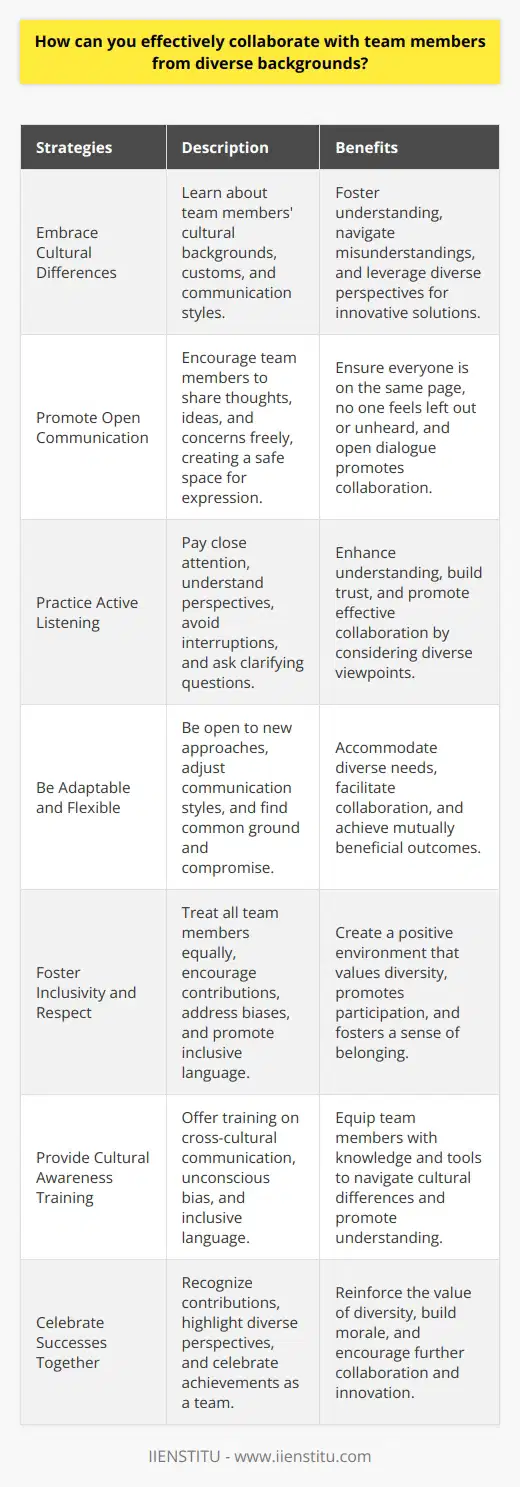
What strategies do you employ to resolve conflicts that may arise within a team setting?
Effective conflict resolution strategies are crucial for maintaining a productive and harmonious team environment. When conflicts arise within a team setting, it is essential to address them promptly and constructively to prevent escalation and minimize negative impacts on team dynamics and performance.
Fostering Open Communication
One of the primary strategies for resolving team conflicts is to encourage open and honest communication among team members. Create a safe space where individuals feel comfortable expressing their concerns, opinions, and ideas without fear of judgment or retaliation. Actively listen to each team member's perspective and ensure that everyone has an opportunity to voice their thoughts.
Facilitating Active Listening
During conflict resolution discussions, emphasize the importance of active listening. Encourage team members to fully understand each other's viewpoints before responding. Ask clarifying questions to gain a deeper understanding of the underlying issues and concerns. By promoting active listening, you foster empathy and create a foundation for finding mutually beneficial solutions.
Identifying Common Ground
When conflicts arise, it is crucial to identify areas of common ground among team members. Look for shared goals, values, or interests that can serve as a starting point for finding a resolution. By focusing on commonalities rather than differences, you can shift the conversation towards a more collaborative and solution-oriented approach.
Encouraging Collaboration
Promote a collaborative mindset within the team. Encourage team members to work together to find creative solutions that address everyone's concerns. Facilitate brainstorming sessions where individuals can contribute ideas and build upon each other's suggestions. By fostering a spirit of collaboration, you create an environment where conflicts are seen as opportunities for growth and improvement.
Mediating Discussions
In some cases, conflicts may require the intervention of a neutral mediator. As a team leader or manager, you can take on this role to facilitate productive discussions and guide the team towards a resolution. Ensure that all parties have an equal opportunity to express their perspectives and concerns. Help the team explore various options and work together to find a mutually agreeable solution.
Maintaining Impartiality
When mediating conflict resolution discussions, it is essential to maintain impartiality. Avoid taking sides or showing favoritism towards any particular team member. Your role is to facilitate open and respectful communication, not to impose your own opinions or judgments. By remaining neutral, you create a fair and unbiased environment that encourages trust and collaboration.
Establishing Clear Expectations and Guidelines
To prevent conflicts from arising in the first place, establish clear expectations and guidelines for team behavior and communication. Develop a team charter or code of conduct that outlines acceptable and unacceptable behaviors, decision-making processes, and conflict resolution procedures. By setting clear boundaries and expectations upfront, you create a framework for addressing conflicts in a structured and consistent manner.
Regularly Reviewing and Updating Guidelines
Periodically review and update the team's conflict resolution guidelines to ensure they remain relevant and effective. Seek feedback from team members and make necessary adjustments based on their experiences and insights. By regularly refining your approach, you demonstrate a commitment to continuous improvement and maintain a proactive stance towards conflict resolution.

Can you describe a situation where you successfully contributed to a team's achievement of a common goal?
I successfully contributed to a team's achievement of a common goal during a group project in my marketing class. Our objective was to develop a comprehensive marketing plan for a local small business. As the team leader, I facilitated effective communication and collaboration among team members. I organized regular meetings to discuss progress, assign tasks, and address any challenges or concerns. By actively listening to each team member's ideas and opinions, I fostered a supportive and inclusive environment that encouraged everyone's participation.
Utilizing Individual Strengths
Recognizing the unique strengths and skills of each team member, I assigned tasks that aligned with their abilities. This strategic allocation of responsibilities maximized our team's efficiency and productivity. I encouraged team members to share their expertise and knowledge, creating a learning opportunity for everyone involved. By leveraging individual strengths, we were able to develop a well-rounded and comprehensive marketing plan that addressed various aspects of the business.
Effective Time Management
To ensure timely completion of the project, I implemented effective time management strategies. I created a detailed timeline with specific milestones and deadlines for each task. This helped keep the team on track and accountable for their assigned responsibilities. I regularly monitored progress and made adjustments as needed to accommodate any unforeseen challenges or delays. By proactively managing our time, we were able to complete the project ahead of schedule without compromising the quality of our work.
Conflict Resolution and Problem-Solving
Throughout the project, I encountered and successfully resolved conflicts and problems that arose within the team. When disagreements emerged regarding the direction of the marketing plan, I facilitated open and respectful discussions to find common ground. I encouraged team members to express their concerns and ideas, actively listening to their perspectives. By promoting a collaborative problem-solving approach, we were able to find creative solutions that satisfied everyone's needs and aligned with the project's goals.
Positive Reinforcement and Motivation
I recognized the importance of maintaining team morale and motivation throughout the project. I regularly acknowledged and praised team members for their hard work and contributions. I celebrated milestones and successes, no matter how small, to keep everyone engaged and motivated. By creating a positive and supportive team environment, I fostered a sense of camaraderie and shared purpose among team members. This positive reinforcement contributed to the team's overall enthusiasm and dedication to achieving our common goal.
Successful Outcome and Reflection
As a result of our collaborative efforts and effective teamwork, we successfully developed a comprehensive marketing plan that exceeded the expectations of our professor and the small business owner. The plan included innovative strategies for market segmentation, target audience identification, promotional activities, and budget allocation. The small business owner expressed gratitude for our work and implemented several of our recommendations, leading to increased brand awareness and customer engagement.
Reflecting on this experience, I learned valuable lessons about the importance of effective leadership, communication, and collaboration in teamwork. By actively contributing to the team's achievement of our common goal, I developed essential skills such as time management, problem-solving, and conflict resolution. This experience reinforced my belief in the power of teamwork and the significance of leveraging individual strengths to achieve collective success.
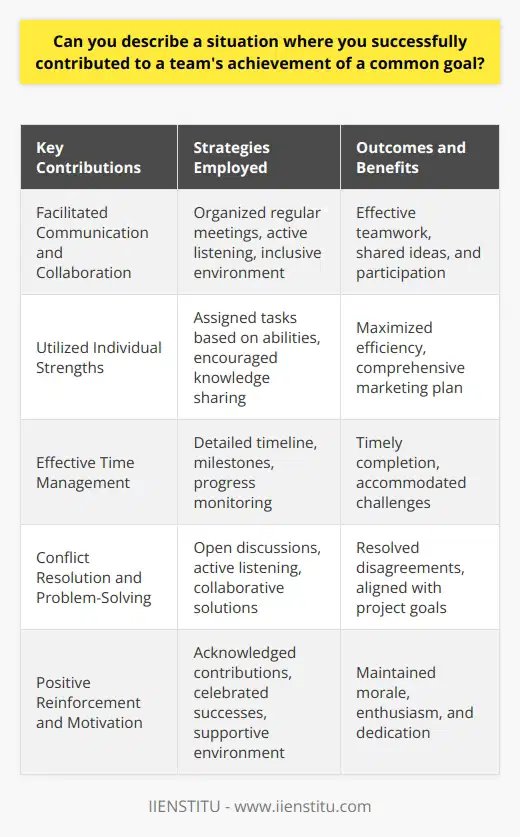
What are some effective strategies for fostering collaboration and trust within a team?
Fostering collaboration and trust within a team is essential for achieving common goals and driving success. Effective strategies for building a cohesive and productive team include open communication, clear roles and responsibilities, and shared decision-making. Leaders should encourage active listening and create a safe space for team members to express their ideas and concerns. Establishing a culture of transparency and accountability helps build trust and promotes a sense of ownership among team members.
Encourage Open Communication
Open communication is the foundation of a collaborative and trusting team environment. Encourage team members to share their thoughts, ideas, and concerns regularly. Create multiple channels for communication, such as team meetings, one-on-one discussions, and digital platforms. Actively listen to team members and provide constructive feedback to foster a dialogue. Regularly check in with team members to ensure they feel heard and valued.
Define Clear Roles and Responsibilities
Clearly defining roles and responsibilities helps team members understand their contributions to the overall goal. Ensure each team member knows their specific tasks, deadlines, and expectations. Provide a written document outlining these roles and responsibilities for easy reference. Regularly review and update these roles as the project evolves to maintain clarity and accountability.
Encourage Shared Decision-Making
Involve team members in the decision-making process to foster a sense of ownership and collaboration. Encourage team members to provide input and ideas during meetings and discussions. Consider all perspectives before making a final decision. Clearly communicate the reasoning behind decisions to maintain transparency and trust.
Build a Culture of Trust
Building trust is essential for fostering collaboration within a team. Lead by example and demonstrate trustworthiness through consistent actions and words. Keep commitments and follow through on promises to show reliability. Admit mistakes and take responsibility for actions to maintain accountability. Encourage team members to do the same to create a culture of trust.
Celebrate Successes and Learn from Failures
Celebrate team successes to boost morale and reinforce positive collaboration. Acknowledge individual contributions and highlight how they contributed to the team's success. When failures occur, treat them as learning opportunities rather than placing blame. Encourage team members to share their insights and ideas for improvement to foster a growth mindset.
Foster a Positive Team Dynamic
Create opportunities for team members to bond and build relationships outside of work. Organize team-building activities, such as group lunches, volunteering events, or social outings. Encourage team members to get to know each other on a personal level to build trust and understanding. Address conflicts promptly and fairly to maintain a positive team dynamic.
Provide Opportunities for Growth and Development
Invest in the growth and development of team members to foster a culture of continuous improvement. Provide opportunities for training, workshops, and conferences to help team members acquire new skills and knowledge. Encourage team members to take on new challenges and responsibilities to promote personal and professional growth. Regularly provide feedback and guidance to support their development.
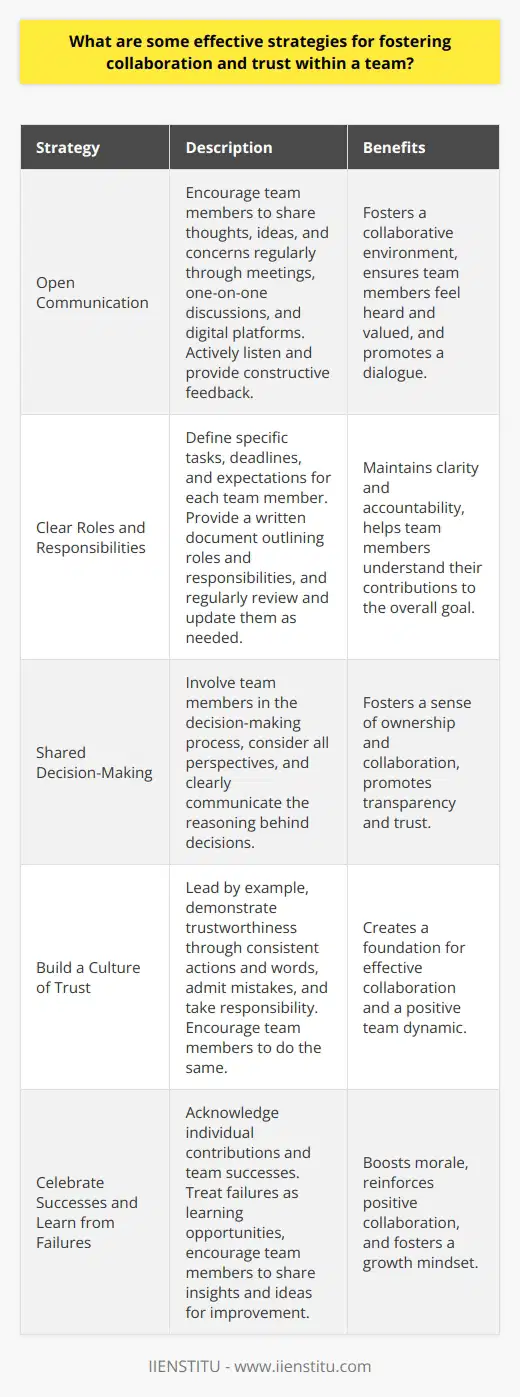
How can conflicts be resolved constructively in a team setting?
Constructively resolving conflicts in a team setting requires open communication, active listening, and a willingness to compromise. Team members should approach conflicts with empathy and understanding, acknowledging each other's perspectives and feelings. Establishing clear roles, responsibilities, and expectations can help prevent misunderstandings and conflicts from arising in the first place.
Encourage Open Communication
Encouraging open and honest communication among team members is crucial for resolving conflicts constructively. Create a safe and non-judgmental environment where team members feel comfortable expressing their thoughts and concerns. Regularly schedule team meetings to discuss progress, challenges, and potential issues before they escalate into conflicts.
Practice Active Listening
Active listening is a key skill in resolving conflicts constructively within a team. Encourage team members to listen attentively to each other without interrupting or making assumptions. Ask clarifying questions to ensure a deeper understanding of each other's perspectives. Paraphrase and summarize what has been said to demonstrate understanding and validate each other's feelings.
Focus on Common Goals
When conflicts arise, remind the team of their shared goals and objectives. Encourage team members to focus on finding solutions that benefit the entire team and align with the project's purpose. Avoid personal attacks or blame, and instead, maintain a solution-oriented approach. Emphasize the importance of collaboration and teamwork in achieving success.
Encourage Compromise and Collaboration
Resolving conflicts often requires compromise and collaboration. Encourage team members to brainstorm potential solutions together, considering each other's needs and concerns. Be willing to make concessions and find middle ground when necessary. Celebrate successful collaborations and compromises to reinforce positive conflict resolution behaviors.
Seek Mediation When Necessary
In some cases, conflicts may require the intervention of a neutral third party, such as a supervisor or mediator. If conflicts persist or escalate, seek guidance from a trusted authority figure who can facilitate a constructive resolution. Ensure that all team members are heard and respected throughout the mediation process.
Learn from Conflicts
Conflicts can provide valuable learning opportunities for teams. After resolving a conflict, take the time to reflect on the experience as a team. Identify the root causes of the conflict and discuss ways to prevent similar issues from arising in the future. Encourage team members to share their insights and lessons learned to foster a culture of continuous improvement.
Celebrate Successes
Acknowledge and celebrate the team's successes in resolving conflicts constructively. Recognize individual and team efforts in maintaining a positive and collaborative work environment. Celebrating successes reinforces the value of effective conflict resolution and encourages team members to continue practicing these skills in the future.
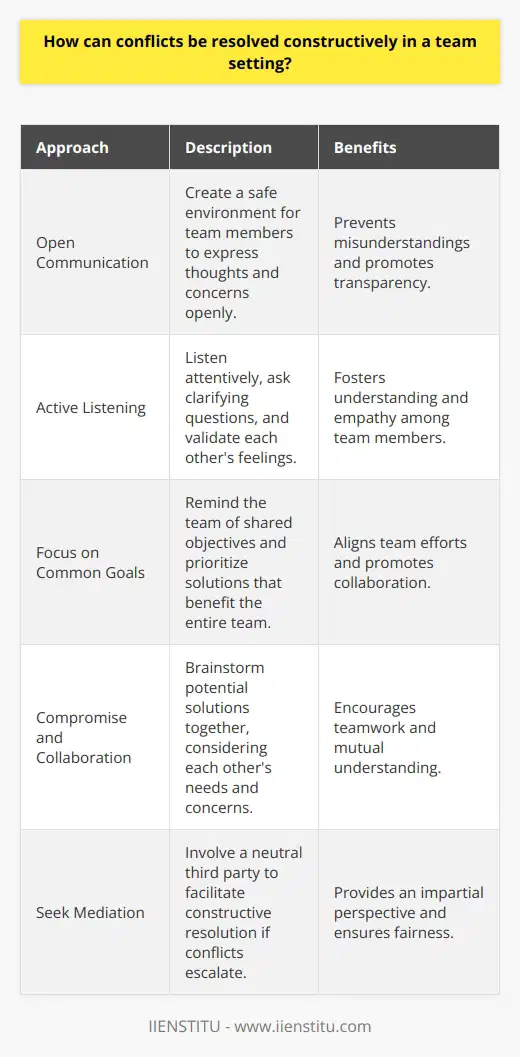
What are the key characteristics of a successful team leader?
A successful team leader possesses several key characteristics that enable them to effectively guide and motivate their team. They demonstrate strong communication skills, ensuring that objectives and expectations are clearly conveyed to team members. Effective leaders also actively listen to their team's concerns and ideas, fostering an environment of open dialogue and collaboration.
Emotional Intelligence and Empathy
Successful team leaders exhibit high levels of emotional intelligence, allowing them to understand and empathize with their team. They recognize the unique strengths and weaknesses of each individual and provide support and guidance when needed. By showing genuine care for their team's well-being, leaders build trust and create a positive work environment.
Adaptability and Flexibility
In today's fast-paced and ever-changing business landscape, adaptability is a crucial trait for successful team leaders. They are able to quickly adjust their strategies and approaches in response to new challenges or opportunities. Flexible leaders are open to new ideas and willing to embrace change when it benefits the team and the organization.
Strategic Thinking and Decision-Making
Effective team leaders possess strong strategic thinking skills, enabling them to see the big picture and make informed decisions. They analyze complex situations, consider multiple perspectives, and develop innovative solutions to achieve team goals. Successful leaders are decisive and take responsibility for their choices, inspiring confidence in their team.
Empowering and Delegating
Great team leaders empower their team members by delegating tasks and responsibilities based on individual strengths and interests. They provide opportunities for growth and development, encouraging team members to take ownership of their work. By fostering a sense of autonomy and trust, leaders create a motivated and engaged team that strives for excellence.
Leading by Example
Successful team leaders lead by example, setting the standard for work ethic, integrity, and professionalism. They are role models who inspire their team to strive for their best and maintain high standards. By consistently demonstrating the behaviors and values they expect from others, leaders earn the respect and loyalty of their team.
Continuous Learning and Improvement
Effective team leaders are lifelong learners who continuously seek opportunities for personal and professional growth. They stay updated with industry trends, acquire new skills, and encourage their team to do the same. Leaders who prioritize continuous improvement create a culture of learning and innovation within their team.
In conclusion, successful team leaders possess a combination of strong communication skills, emotional intelligence, adaptability, strategic thinking, empowerment, leading by example, and a commitment to continuous learning. By embodying these characteristics, leaders can effectively guide their team towards achieving common goals and driving organizational success.
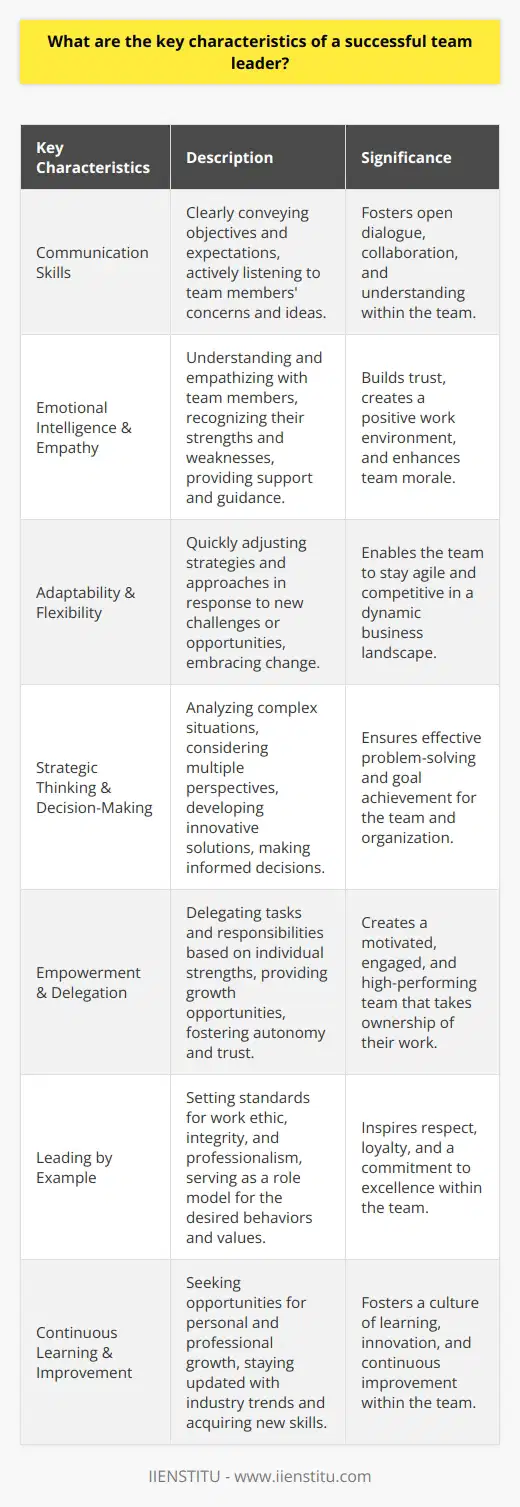
What are the key elements of effective teamwork?
Effective teamwork is crucial for the success of any group project or collaborative endeavor. Several key elements contribute to the formation and maintenance of high-performing teams. These include clear communication, well-defined roles and responsibilities, shared goals, trust and respect among team members, and effective leadership.
Clear Communication
Open and clear communication is the foundation of effective teamwork. Team members should feel comfortable expressing their ideas, concerns, and feedback. Regular meetings, whether in-person or virtual, help ensure everyone is on the same page. Active listening and constructive feedback are essential for maintaining a positive team dynamic.
Well-Defined Roles and Responsibilities
Each team member should have a clear understanding of their specific role and responsibilities within the group. This clarity helps prevent confusion, duplication of efforts, and potential conflicts. When roles are well-defined, team members can focus on their strengths and contribute effectively to the overall goal.
Establishing Roles
Roles should be assigned based on individual skills, experience, and interests. Consider each team member's strengths and weaknesses when assigning tasks. Ensure that everyone understands their role and how it contributes to the team's success.
Maintaining Accountability
Hold team members accountable for their assigned tasks and responsibilities. Regularly check in on progress and offer support when needed. Celebrate successes and learn from setbacks as a team.
Shared Goals
Effective teams have a clear, shared vision of what they want to achieve. All team members should understand and be committed to the common goal. Break down the overall goal into smaller, manageable tasks and milestones. Regularly review progress and adjust strategies as needed to stay on track.
Trust and Respect
Trust and respect are essential for building strong, cohesive teams. Team members should feel valued, supported, and appreciated for their contributions. Foster an inclusive environment where diverse perspectives are welcomed and encouraged. Treat each other with kindness, empathy, and professionalism.
Building Trust
Building trust takes time and effort. Be reliable, follow through on commitments, and maintain confidentiality when appropriate. Show genuine interest in your teammates' well-being and support them during challenges.
Demonstrating Respect
Respect each other's time, opinions, and boundaries. Avoid interrupting or dismissing ideas without consideration. Provide constructive feedback and praise when warranted. Celebrate each other's successes and offer support during setbacks.
Effective Leadership
Strong leadership is crucial for guiding teams towards success. Effective leaders provide direction, support, and motivation. They foster a positive team culture, facilitate communication, and resolve conflicts when they arise. Leaders should also be open to feedback and willing to adapt their approach when necessary.
Leading by Example
Leaders should model the behavior and work ethic they expect from their team. Demonstrate commitment, integrity, and professionalism in all interactions. Be willing to roll up your sleeves and work alongside your team when needed.
Empowering Team Members
Empower team members to take ownership of their work and make decisions within their scope of responsibility. Provide the resources, training, and support they need to succeed. Encourage innovation and creativity, and be open to new ideas and approaches.
By focusing on these key elements of effective teamwork, groups can foster a positive, collaborative environment that leads to successful outcomes. Building and maintaining high-performing teams requires ongoing effort and commitment from all members, but the rewards are well worth the investment.
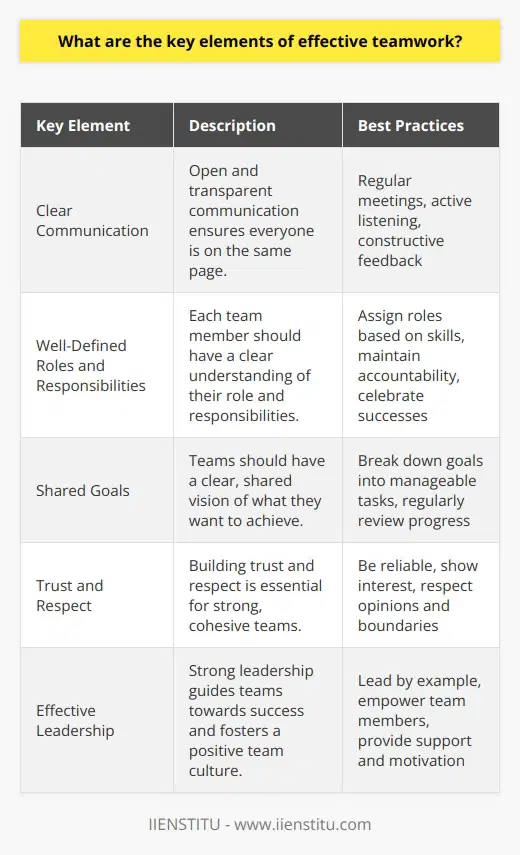
How can conflicts within a team be resolved productively?
Conflicts within a team can be resolved productively by employing effective communication and problem-solving strategies. Team members should actively listen to each other's concerns and perspectives to gain a comprehensive understanding of the issue at hand. Open and honest dialogue is crucial in identifying the root cause of the conflict and finding common ground.
Encourage Open Communication
Encouraging open communication among team members is essential for resolving conflicts. Create a safe and non-judgmental environment where individuals feel comfortable expressing their thoughts and feelings. Regularly schedule team meetings or one-on-one discussions to address any concerns or disagreements that may arise. Promote active listening and ensure that each team member has an opportunity to voice their opinions.
Practice Active Listening
Active listening is a key component of effective communication. When a team member is expressing their concerns, give them your full attention. Avoid interrupting or formulating a response while they are speaking. Instead, focus on understanding their perspective and the emotions behind their words. Ask clarifying questions to ensure that you have a clear grasp of their viewpoint.
Identify the Root Cause
To resolve conflicts productively, it is important to identify the underlying reasons for the disagreement. Encourage team members to express their concerns openly and honestly. Ask probing questions to uncover the root cause of the conflict. Is it a misunderstanding, a difference in values, or a lack of resources? Once the root cause is identified, the team can work together to find a solution.
Brainstorm Solutions
Once the root cause of the conflict is identified, engage the team in brainstorming potential solutions. Encourage everyone to contribute their ideas and perspectives. Create a non-judgmental atmosphere where all suggestions are welcomed and considered. Evaluate each proposed solution based on its feasibility, effectiveness, and alignment with the team's goals and values.
Seek Compromise
In many cases, resolving conflicts requires finding a middle ground. Encourage team members to be open to compromise. Look for win-win solutions that address the concerns of all parties involved. Be willing to make concessions and find a mutually beneficial outcome. Remember that the goal is to maintain a collaborative and productive team environment.
Implement and Monitor Solutions
Once a solution is agreed upon, develop a clear action plan for implementation. Assign responsibilities and establish timelines for each step of the plan. Ensure that all team members understand their roles and are committed to the resolution process. Regularly monitor progress and provide support and guidance as needed.
Learn from Conflicts
Conflicts can provide valuable learning opportunities for the team. After a conflict is resolved, take time to reflect on the experience. Identify any patterns or recurring issues that may need to be addressed. Use the insights gained to strengthen the team's communication skills, problem-solving abilities, and overall cohesion.
By fostering open communication, actively listening, identifying root causes, brainstorming solutions, seeking compromise, implementing action plans, and learning from conflicts, teams can resolve conflicts productively. This approach promotes a positive team dynamic, enhances collaboration, and ultimately leads to improved performance and success.
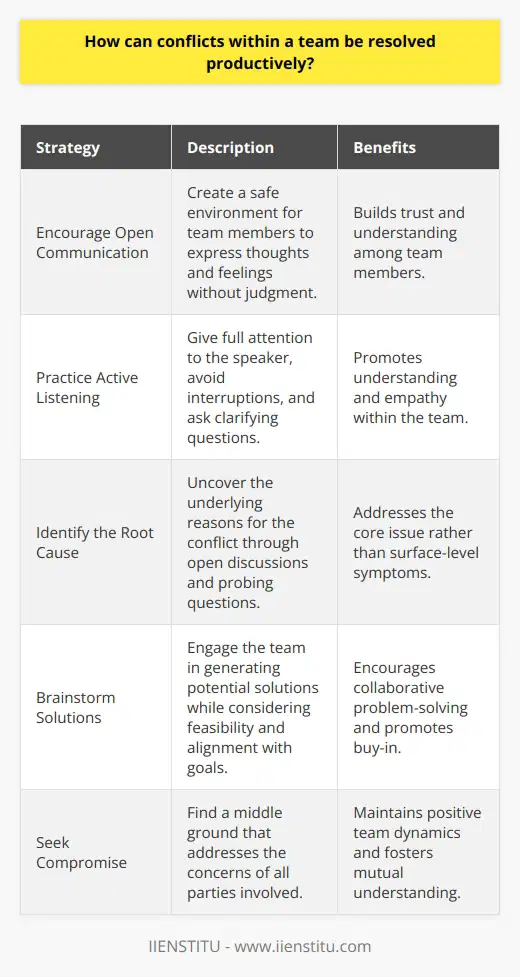
What strategies can be employed to foster a collaborative team environment?
Fostering a collaborative team environment is crucial for the success and productivity of any organization. Several strategies can be employed to promote collaboration and teamwork among employees. One effective approach is to establish clear communication channels that encourage open dialogue and information sharing among team members. This can be achieved through regular team meetings, brainstorming sessions, and the use of collaborative tools such as project management software and instant messaging platforms.
Encourage Diversity and Inclusivity
Another key strategy is to foster an inclusive and diverse work environment that values and respects individual differences. By embracing diversity, teams can benefit from a wide range of perspectives, skills, and experiences, leading to more creative and innovative solutions. Leaders should actively promote inclusivity by ensuring that all team members have equal opportunities to contribute and participate in decision-making processes.
Provide Training and Development Opportunities
Investing in employee training and development is another effective way to foster collaboration within teams. By providing opportunities for employees to enhance their skills and knowledge, organizations can create a culture of continuous learning and growth. This not only improves individual performance but also promotes a sense of shared purpose and teamwork as employees work together to achieve common goals.
Recognize and Reward Collaborative Efforts
Recognizing and rewarding collaborative efforts is also crucial in fostering a collaborative team environment. Leaders should acknowledge and celebrate the successes of teams that work effectively together, highlighting the value of collaboration in achieving organizational objectives. This can be done through formal recognition programs, such as employee awards or bonuses, as well as informal gestures of appreciation, such as public praise or team celebrations.
Lead by Example
Finally, leaders play a critical role in fostering a collaborative team environment by leading by example. They should model collaborative behavior by actively listening to team members, encouraging open communication, and demonstrating a willingness to work together towards common goals. By setting a positive example, leaders can inspire their teams to embrace collaboration as a core value and work together more effectively.
In conclusion, fostering a collaborative team environment requires a multi-faceted approach that includes clear communication, inclusivity, training and development, recognition and rewards, and strong leadership. By implementing these strategies, organizations can create a culture of collaboration that drives innovation, productivity, and success.

What strategies do you employ to foster collaboration and cohesion among team members?
Fostering collaboration and cohesion among team members is crucial for the success of any project or organization. Several strategies can be employed to promote effective teamwork and create a harmonious working environment. One of the most important approaches is to establish clear communication channels within the team. This involves setting up regular meetings, either in-person or virtual, where team members can share updates, discuss challenges, and brainstorm ideas. By encouraging open and transparent communication, team members can build trust, resolve conflicts, and work together more efficiently.
Defining Roles and Responsibilities
Another key strategy is to clearly define roles and responsibilities within the team. Each team member should have a specific set of tasks and objectives that align with their skills and expertise. This helps to avoid confusion, duplication of efforts, and ensures that everyone is working towards a common goal. By providing team members with a sense of ownership and accountability, they are more likely to be engaged and motivated to contribute to the team's success.
Encouraging Collaboration and Knowledge Sharing
Encouraging collaboration and knowledge sharing among team members is also essential. This can be achieved by creating opportunities for team members to work together on projects, share best practices, and learn from each other. One effective approach is to implement a mentoring program, where experienced team members can guide and support newer members. This not only helps to build skills and expertise within the team but also fosters a sense of camaraderie and mutual support.
Promoting a Positive Team Culture
Promoting a positive team culture is another crucial aspect of fostering collaboration and cohesion. This involves creating an environment where team members feel valued, respected, and supported. Encouraging a culture of recognition and appreciation, where team members are acknowledged for their contributions and achievements, can go a long way in boosting morale and motivation. Additionally, organizing team-building activities and social events can help to strengthen relationships and create a sense of belonging within the team.
Resolving Conflicts and Challenges
Finally, it is important to have strategies in place for resolving conflicts and addressing challenges that may arise within the team. This involves promoting open and honest communication, actively listening to team members' concerns, and working together to find mutually beneficial solutions. By fostering a culture of respect, empathy, and collaboration, team members are more likely to work through differences and overcome obstacles together.
Conclusion
In conclusion, fostering collaboration and cohesion among team members requires a multi-faceted approach. By establishing clear communication channels, defining roles and responsibilities, encouraging collaboration and knowledge sharing, promoting a positive team culture, and having strategies in place for resolving conflicts, leaders can create a highly effective and cohesive team. By investing in these strategies, organizations can unlock the full potential of their teams and achieve greater success in today's fast-paced and ever-changing business environment.
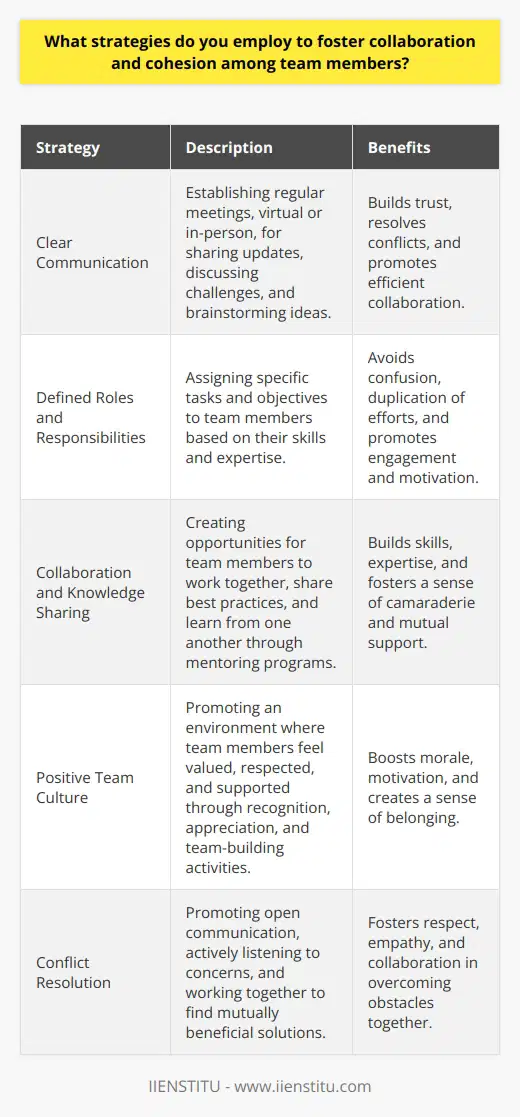
How do you handle conflicts or disagreements that arise within your team?
When conflicts or disagreements arise within a team, it's essential to address them promptly and effectively. The first step is to identify the root cause of the issue and gather all relevant information from the parties involved. This process should be done objectively, without bias or prejudice, to ensure a fair resolution.
Open Communication
Encourage open and honest communication among team members to foster a safe environment for expressing concerns and ideas. Listen actively to each person's perspective and ensure that everyone has an opportunity to voice their thoughts. Promote a culture of respect and empathy, where team members feel valued and heard.
Identify Common Ground
Focus on finding common ground and shared goals among the conflicting parties. Emphasize the importance of working together towards a solution that benefits the entire team and aligns with the organization's objectives. Encourage team members to set aside personal differences and prioritize the team's success.
Brainstorm Solutions
Engage the team in brainstorming sessions to generate potential solutions to the conflict or disagreement. Encourage creative thinking and open-mindedness during these sessions. Evaluate each solution based on its feasibility, effectiveness, and alignment with the team's goals and values.
Implement and Monitor
Once a solution has been agreed upon, develop a clear action plan for implementation. Assign roles and responsibilities to team members and set realistic timelines for completion. Monitor progress regularly and make adjustments as needed to ensure the solution remains effective and sustainable.
Learn from Experience
Treat each conflict or disagreement as an opportunity for growth and learning. Reflect on the situation and identify areas for improvement in communication, collaboration, and problem-solving. Encourage team members to share their insights and lessons learned to prevent similar issues from arising in the future.
Seek External Support
In some cases, conflicts or disagreements may require the intervention of an external mediator or facilitator. Don't hesitate to seek professional support when necessary to ensure a fair and unbiased resolution process. This can be particularly helpful in situations where emotions are running high, or the issue is complex and multifaceted.
By approaching conflicts and disagreements with a proactive, solution-oriented mindset, teams can navigate challenges and emerge stronger and more unified. Effective conflict resolution skills are essential for maintaining a positive team dynamic and ensuring long-term success.

In what ways do you motivate and inspire your team to achieve their goals?
Motivating and inspiring a team to achieve their goals is a crucial aspect of effective leadership. One key strategy is to set clear, achievable objectives that align with the team's strengths and aspirations. By providing a sense of purpose and direction, leaders can foster a shared vision that unites and energizes the group. Regular communication is also essential, as it allows leaders to offer guidance, feedback, and recognition for progress made.
Fostering a Positive Work Environment
Creating a supportive and collaborative work environment is another powerful way to motivate and inspire a team. Leaders should encourage open communication, actively listen to team members' ideas and concerns, and promote a culture of trust and respect. By valuing each individual's contributions and fostering a sense of belonging, leaders can boost morale and engagement. Additionally, providing opportunities for growth and development, such as training programs or mentorship, can help team members feel invested in their roles and motivated to excel.
Leading by Example
Effective leaders also inspire their teams by modeling the behaviors and attitudes they wish to see. By demonstrating a strong work ethic, resilience in the face of challenges, and a commitment to excellence, leaders can set a powerful example for others to follow. They should also be willing to roll up their sleeves and work alongside their team, showing that they are not above the tasks they assign. By embodying the values and goals of the organization, leaders can inspire their team to do the same.
Celebrating Successes and Learning from Setbacks
Recognizing and celebrating the team's successes is another key way to keep motivation high. Leaders should make a point of acknowledging individual and collective achievements, whether through public praise, bonuses, or other rewards. At the same time, they should also help the team learn from setbacks and failures, framing them as opportunities for growth and improvement. By maintaining a positive outlook and focusing on solutions rather than blame, leaders can help their team stay resilient and committed to their goals.
Empowering Team Members
Finally, leaders can inspire their team by empowering them to take ownership of their work and make decisions. By delegating tasks, providing autonomy, and trusting team members to use their skills and judgment, leaders can foster a sense of responsibility and pride in the team's accomplishments. They should also be open to new ideas and approaches, encouraging team members to think creatively and take calculated risks. By creating an environment where everyone feels valued and able to contribute their best, leaders can unleash the full potential of their team.
Conclusion
In summary, motivating and inspiring a team requires a multifaceted approach that combines clear goals, a positive work environment, leading by example, celebrating successes, and empowering team members. By consistently applying these strategies, leaders can create a culture of excellence and achievement that drives their team to new heights.

What are some examples of how you have demonstrated teamwork in your previous roles?
Demonstrating teamwork in previous roles is essential for showcasing your ability to collaborate effectively with others. One example of how I have demonstrated teamwork is through active participation in team meetings and brainstorming sessions. By actively listening to my colleagues' ideas and offering constructive feedback, I contributed to the development of innovative solutions and fostered a collaborative work environment.
Effective Communication
Another way I have demonstrated teamwork is by maintaining open and transparent communication with my team members. I actively shared relevant information, updates, and progress reports to ensure everyone was on the same page. By keeping communication channels open, I helped prevent misunderstandings and facilitated smooth project execution.
Conflict Resolution
When conflicts arose within the team, I took the initiative to address and resolve them professionally. I actively listened to different perspectives, facilitated open discussions, and worked towards finding mutually beneficial solutions. By promoting a positive and respectful work environment, I helped maintain team cohesion and productivity.
Collaborative Problem-Solving
I have also demonstrated teamwork by actively participating in collaborative problem-solving sessions. When faced with complex challenges, I engaged in discussions with my team members to analyze the situation from various angles. By pooling our collective knowledge and expertise, we were able to generate creative solutions and overcome obstacles more effectively.
Supporting Team Members
Demonstrating teamwork also involves supporting and assisting team members when needed. I have readily offered my help and expertise to my colleagues, whether it was through providing guidance, sharing resources, or taking on additional tasks to ensure the team's success. By being a reliable and supportive team player, I contributed to a positive and collaborative work environment.
Recognizing and Celebrating Success
Lastly, I have demonstrated teamwork by recognizing and celebrating the successes and achievements of my team members. I made a point to acknowledge and appreciate the contributions of others, whether through verbal praise, written acknowledgments, or advocating for their recognition within the organization. By celebrating team successes, I fostered a sense of unity and motivation among team members.
Conclusion
In summary, demonstrating teamwork in previous roles involves active participation, effective communication, conflict resolution, collaborative problem-solving, supporting team members, and recognizing and celebrating success. By consistently exhibiting these behaviors, I have contributed to building strong, cohesive, and high-performing teams in my previous roles.

How do you handle conflicts or disagreements within a team?
Handling conflicts or disagreements within a team is a crucial skill for maintaining productivity and harmony. The first step in addressing conflicts is to identify the root cause of the issue. This may involve open and honest communication with team members to understand their perspectives. Active listening is essential during this process, as it allows each person to feel heard and validated.
Encourage Open Communication
Encouraging open communication among team members is vital for preventing and resolving conflicts. Create a safe and non-judgmental environment where everyone feels comfortable expressing their thoughts and concerns. Regularly schedule team meetings or one-on-one discussions to provide opportunities for dialogue. When conflicts arise, address them promptly and directly to prevent them from escalating.
Practice Active Listening
Active listening is a powerful tool for understanding others' perspectives and finding common ground. When a team member expresses their concerns, give them your full attention. Avoid interrupting or forming a response before they finish speaking. Paraphrase their words to ensure you have understood their message correctly. Ask clarifying questions to gain a deeper understanding of their viewpoint.
Find Common Ground
When conflicts arise, focus on finding common ground rather than emphasizing differences. Identify the shared goals and values that unite the team. Encourage team members to recognize that everyone wants the best for the project or organization. By highlighting common interests, you can create a foundation for collaboration and compromise.
Brainstorm Solutions
Once you have identified the root cause of the conflict and found common ground, brainstorm potential solutions together. Encourage all team members to contribute ideas and suggestions. Evaluate each option objectively, considering the pros and cons. Strive for a solution that addresses the concerns of all parties involved and aligns with the team's goals.
Seek Mediation if Necessary
In some cases, conflicts may be too complex or emotionally charged for the team to resolve independently. If the situation escalates or remains unresolved, consider seeking the assistance of a neutral mediator. This could be a supervisor, HR representative, or an external professional. A mediator can facilitate productive conversations, ensure all parties are heard, and guide the team towards a mutually acceptable resolution.
Foster a Positive Team Culture
Creating a positive team culture can help prevent conflicts from arising in the first place. Encourage a spirit of collaboration, respect, and open-mindedness among team members. Celebrate successes together and acknowledge individual contributions. Foster an environment where constructive feedback is welcomed and used for growth and improvement.
Lead by Example
As a team leader or member, it is essential to lead by example when handling conflicts. Demonstrate active listening, empathy, and a willingness to compromise. Avoid engaging in gossip or negative talk about team members. Treat everyone with respect and professionalism, even in challenging situations. By modeling the behavior you expect from others, you can set a positive tone for conflict resolution within the team.
Handling conflicts or disagreements within a team requires patience, empathy, and effective communication skills. By encouraging open dialogue, finding common ground, and brainstorming solutions together, teams can navigate challenges and maintain a productive and harmonious working environment. Remember, conflicts are opportunities for growth and strengthening team bonds when approached with a positive and constructive mindset.

Can you describe a time when you had to collaborate with a difficult team member and how you approached the situation?
Collaborating with difficult team members is a common challenge in various professional settings. In one particular instance, I found myself working on a critical project with a colleague who consistently exhibited uncooperative behavior. This individual often disregarded deadlines, failed to communicate effectively, and seemed reluctant to contribute to the team's efforts. Recognizing the potential impact on the project's success, I knew I had to address the situation proactively.
Initiating Open Communication
The first step I took was to initiate an open and honest conversation with the difficult team member. I approached them in a non-confrontational manner, expressing my concerns about their lack of engagement and the effect it was having on the project. By creating a safe space for dialogue, I aimed to understand their perspective and identify any underlying issues that might be contributing to their behavior.
Active Listening and Empathy
During our conversation, I made a conscious effort to practice active listening and demonstrate empathy. I acknowledged their feelings and tried to see the situation from their point of view. By validating their concerns and showing genuine interest in finding a solution, I hoped to build trust and foster a more collaborative relationship.
Establishing Clear Expectations
Next, I worked with the team member to establish clear expectations and responsibilities. We broke down the project into smaller tasks and set specific deadlines for each milestone. By providing a structured framework and defining individual roles, I aimed to minimize ambiguity and ensure everyone understood their contributions to the project's success.
Regular Check-Ins and Feedback
To maintain accountability and monitor progress, I scheduled regular check-ins with the team member. These meetings served as opportunities to provide constructive feedback, discuss any challenges they were facing, and offer support or guidance when needed. By maintaining open lines of communication, I sought to address issues promptly and prevent them from escalating.
Leveraging Strengths and Delegating Tasks
Despite the initial difficulties, I recognized that every team member brings unique strengths to the table. I took the time to identify the difficult team member's skills and expertise. By delegating tasks that aligned with their strengths, I aimed to boost their confidence and engagement while ensuring they could contribute meaningfully to the project.
Leading by Example
Throughout the collaboration, I strived to lead by example. I maintained a professional and respectful demeanor, even in challenging situations. By demonstrating a strong work ethic, meeting my own deadlines, and actively participating in team discussions, I hoped to inspire and motivate the difficult team member to follow suit.
Celebrating Successes and Learning from Setbacks
As the project progressed, I made sure to acknowledge and celebrate the team's successes, including the contributions of the difficult team member. By recognizing their efforts and highlighting the positive impact of their work, I aimed to reinforce the importance of collaboration and teamwork. When setbacks occurred, I encouraged the team to view them as learning opportunities and worked together to find solutions.
In conclusion, collaborating with a difficult team member requires patience, empathy, and effective communication. By initiating open dialogue, establishing clear expectations, leveraging individual strengths, and leading by example, I was able to navigate the challenges and foster a more productive working relationship. While it was not always easy, the experience taught me valuable lessons in leadership, conflict resolution, and the importance of building strong, cohesive teams.

What was your most rewarding experience working collaboratively with a team, and how did you personally contribute to the team's success?
One of my most rewarding experiences working collaboratively with a team was during a marketing campaign project. Our objective was to develop a comprehensive strategy to promote a new product line. The team consisted of individuals from various departments, including marketing, sales, and product development.
Developing a Cohesive Strategy
To ensure the success of the project, we needed to develop a cohesive strategy that aligned with the company's goals. Each team member brought a unique perspective and expertise to the table. We actively listened to one another's ideas and provided constructive feedback. Through open communication and brainstorming sessions, we were able to create a well-rounded marketing plan.
My Personal Contribution
As a member of the marketing team, I took the lead in conducting market research and analyzing competitor strategies. I gathered valuable insights into consumer preferences and market trends. Using this information, I collaborated with the team to identify key target audiences and develop targeted messaging.
Additionally, I worked closely with the product development team to ensure that our marketing efforts accurately represented the product's features and benefits. I provided input on packaging design and contributed to the creation of promotional materials.
Overcoming Challenges
Throughout the project, we encountered various challenges, such as tight deadlines and budget constraints. However, our team remained focused and adaptable. We regularly communicated progress updates and addressed any obstacles promptly. By leveraging each other's strengths and maintaining a positive attitude, we were able to overcome these challenges and stay on track.
Successful Outcome
Through our collaborative efforts, we successfully launched the new product line on time and within budget. The marketing campaign generated significant buzz and exceeded our initial sales projections. It was incredibly rewarding to see our hard work pay off and witness the positive impact on the company's bottom line.
Lessons Learned
This experience taught me the importance of effective communication, adaptability, and leveraging individual strengths within a team setting. I learned that by actively listening to others and being open to diverse perspectives, we can generate innovative ideas and make better decisions.
Moreover, I realized the significance of setting clear goals, establishing roles and responsibilities, and regularly assessing progress. By having a shared vision and working towards a common objective, teams can achieve remarkable results.
Conclusion
Collaborating with this team on the marketing campaign project was an incredibly rewarding experience. It highlighted the power of teamwork, effective communication, and leveraging individual strengths. Through our collective efforts, we were able to develop a successful strategy, overcome challenges, and achieve our goals. This experience has strengthened my ability to work collaboratively and has reinforced the importance of fostering a positive team dynamic.
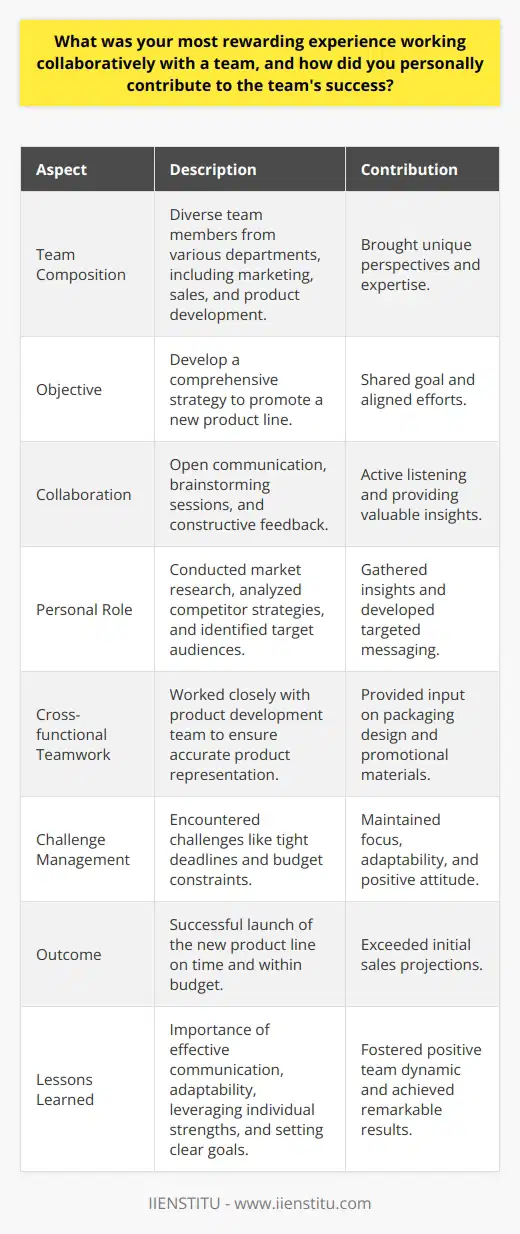
In your opinion, what are the key elements that make teamwork most effective, and how have you exemplified those qualities in a team setting?
Effective teamwork is essential for achieving common goals and driving success in various settings. Several key elements contribute to the efficacy of a team, including clear communication, well-defined roles and responsibilities, mutual respect, and a shared vision. Clear communication ensures that all team members are on the same page, understanding their tasks and deadlines. Well-defined roles and responsibilities prevent confusion and duplication of efforts, allowing each member to focus on their strengths. Mutual respect fosters a positive team dynamic, where everyone's opinions and contributions are valued. A shared vision unites the team, providing a common purpose and direction.
In my experience, I have exemplified these qualities in various team settings. I actively listen to my teammates, ensuring that I understand their perspectives and ideas. I communicate clearly and concisely, sharing relevant information and updates in a timely manner. When working on projects, I take responsibility for my assigned tasks and deliver high-quality work within the agreed-upon deadlines. I also offer support and assistance to my teammates when needed, fostering a collaborative environment.
Promoting Open Communication
One of the most critical aspects of effective teamwork is promoting open communication. I encourage my teammates to share their thoughts, ideas, and concerns freely. By creating a safe and inclusive space for dialogue, we can identify potential challenges early on and develop creative solutions together. I also make sure to provide constructive feedback and praise, acknowledging the efforts and achievements of my team members.
Adapting to Different Work Styles
Recognizing and adapting to different work styles is another important aspect of successful teamwork. I take the time to understand the preferences and strengths of my teammates, adjusting my approach accordingly. For example, when working with a detail-oriented teammate, I ensure that I provide thorough and well-organized information. When collaborating with a more visually-oriented colleague, I incorporate diagrams and visuals to better convey my ideas.
Leading by Example
As a team member, I strive to lead by example, demonstrating a strong work ethic and a positive attitude. I take initiative when necessary, stepping up to fill gaps and support my teammates. I also maintain a professional demeanor, even in challenging situations, and work to find constructive solutions to any conflicts that may arise. By setting a positive example, I hope to inspire my teammates to do the same, creating a cohesive and high-performing team.
Celebrating Successes and Learning from Failures
Finally, I believe in the importance of celebrating successes and learning from failures as a team. When we achieve our goals, I make sure to acknowledge the contributions of each team member and take the time to celebrate our accomplishments together. When faced with setbacks or challenges, I encourage my team to view them as opportunities for growth and learning. By maintaining a positive outlook and focusing on continuous improvement, we can overcome obstacles and emerge stronger as a team.
Conclusion
In conclusion, effective teamwork is built on a foundation of clear communication, well-defined roles and responsibilities, mutual respect, and a shared vision. By exemplifying these qualities and promoting open communication, adapting to different work styles, leading by example, and celebrating successes while learning from failures, I have contributed to the success of various teams. As I continue to grow and develop as a professional, I remain committed to being a valuable and supportive team member, helping to drive positive outcomes and foster a collaborative environment.
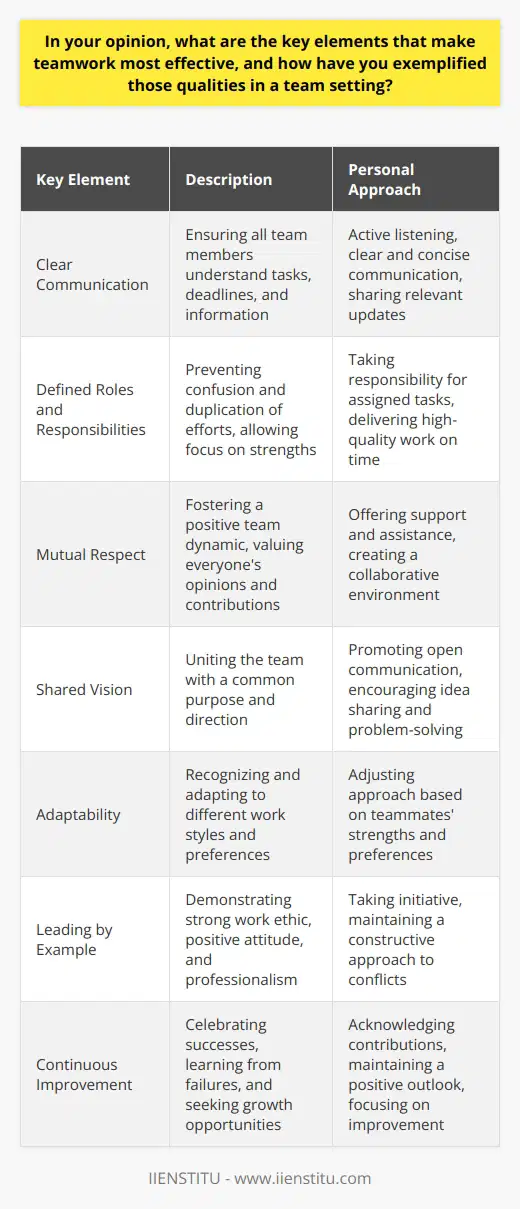
Can you describe a time when you faced challenges while working with a team, and how did you overcome those obstacles to achieve your goals?
Working in a team can present various challenges, but effective communication and collaboration are key to overcoming obstacles and achieving goals. During a group project in my marketing class, I encountered difficulties due to conflicting schedules and differing opinions among team members. To address these issues, I took the initiative to schedule regular meetings and facilitate open discussions.
Establishing Clear Communication
I encouraged my teammates to share their ideas and concerns openly, ensuring that everyone had a chance to contribute. By actively listening and considering each person's perspective, we were able to find common ground and develop a shared vision for the project. I also made sure to clarify roles and responsibilities, so each team member knew what was expected of them.
Adapting to Changing Circumstances
As the project progressed, we encountered unexpected setbacks that required us to adjust our approach. I remained flexible and open to new ideas, encouraging my teammates to think creatively and explore alternative solutions. By fostering a supportive and adaptable environment, we were able to navigate these challenges and stay on track towards our goals.
Leveraging Individual Strengths
Recognizing the unique skills and strengths of each team member was crucial to our success. I made an effort to understand my teammates' abilities and assign tasks that played to their strengths. By leveraging our individual talents and expertise, we were able to work more efficiently and produce higher-quality results.
Leading by Example
As a team leader, I understood the importance of setting a positive example for my teammates. I consistently demonstrated a strong work ethic, reliability, and a commitment to excellence. By modeling these qualities, I inspired my teammates to do their best work and maintain a high standard of performance throughout the project.
Celebrating Successes and Learning from Challenges
Throughout the project, I made sure to acknowledge and celebrate our successes, no matter how small. Recognizing our progress helped to keep the team motivated and focused on our ultimate goal. When we encountered challenges, I encouraged my teammates to view them as opportunities for growth and learning. By maintaining a positive attitude and embracing a growth mindset, we were able to overcome obstacles and emerge stronger as a team.
In conclusion, working effectively in a team requires strong communication, adaptability, and a willingness to leverage individual strengths. By fostering a supportive and collaborative environment, leaders can help their teams overcome challenges and achieve their goals. Through this experience, I learned valuable lessons about leadership, teamwork, and the importance of perseverance in the face of adversity.

How do you contribute to a team's success?
Contributing to a team's success involves a combination of individual efforts and collaborative skills. Each team member plays a crucial role in achieving common goals and objectives. To effectively contribute to a team's success, one must possess a range of qualities and abilities.
Effective Communication
Clear and concise communication is essential for successful teamwork. Share ideas, thoughts, and concerns openly and respectfully. Listen actively to your teammates and ensure that everyone's voice is heard. Effective communication helps prevent misunderstandings and fosters a positive team dynamic.
Reliability and Dependability
Being reliable and dependable is crucial for building trust within the team. Complete your assigned tasks on time and to the best of your abilities. If you encounter challenges or delays, inform your teammates promptly. Consistently delivering high-quality work demonstrates your commitment to the team's success.
Proactive Problem-Solving
Take initiative in identifying and addressing potential issues or obstacles. Anticipate challenges and propose solutions to mitigate risks. Encourage brainstorming sessions and actively participate in problem-solving discussions. By being proactive, you contribute to the team's ability to overcome hurdles and maintain progress.
Adaptability and Flexibility
Teams often face changing circumstances and requirements. Embrace adaptability and be open to adjusting your approach when necessary. Be willing to take on new roles or responsibilities to support the team's needs. Flexibility allows the team to remain agile and responsive to evolving demands.
Continuous Learning and Growth
Actively seek opportunities to expand your knowledge and skills. Stay updated with industry trends and best practices relevant to your team's goals. Share your insights and expertise with your teammates to foster a culture of continuous learning. Encourage others to grow and develop their abilities as well.
Collaboration and Teamwork
Embrace a collaborative mindset and actively engage in teamwork. Offer support and assistance to your teammates when needed. Recognize and leverage each team member's strengths to create synergy and achieve better results. Foster a positive and inclusive team environment that encourages open collaboration and mutual respect.
Constructive Feedback and Improvement
Provide constructive feedback to your teammates to help them improve and grow. Be open to receiving feedback yourself and use it as an opportunity for personal and professional development. Continuously seek ways to enhance your own performance and contribute to the team's overall improvement.
Celebrating Successes and Learning from Failures
Acknowledge and celebrate the team's successes, no matter how small. Recognize individual contributions and express appreciation for everyone's efforts. When the team faces setbacks or failures, approach them as learning opportunities. Analyze what went wrong, identify areas for improvement, and work together to develop strategies for future success.
By embodying these qualities and consistently working towards the team's goals, you can significantly contribute to the team's success. Remember that teamwork is a collective effort, and every member's dedication and commitment are essential for achieving outstanding results.
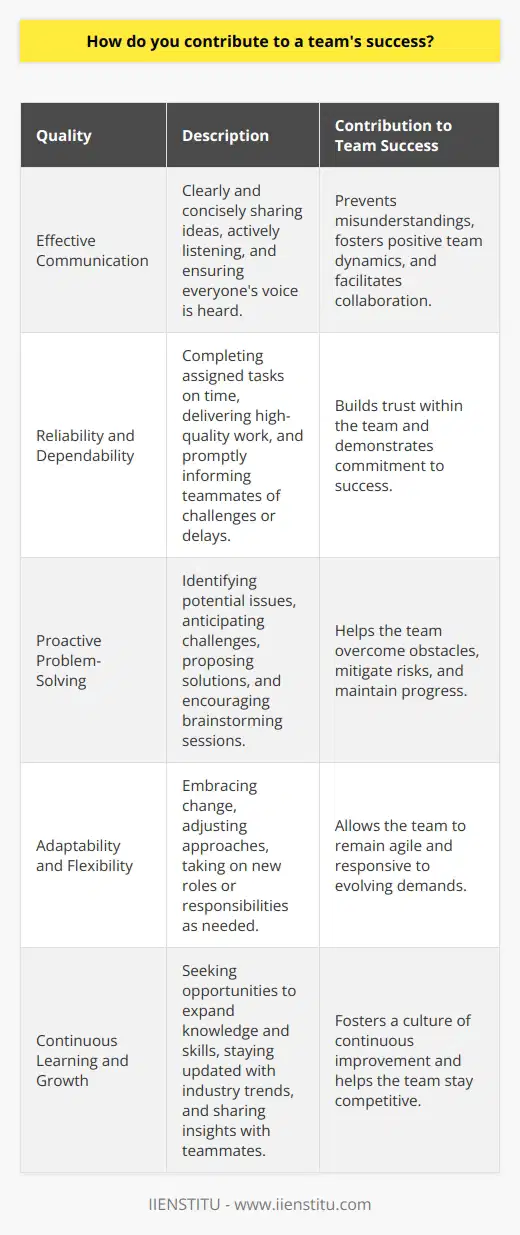
What strategies do you employ to foster collaboration within a team?
Fostering collaboration within a team requires a multifaceted approach that addresses communication, trust, and shared goals. Effective strategies include establishing clear communication channels, such as regular meetings and project management tools, to ensure everyone is informed and aligned. Building trust among team members is crucial, which can be achieved by promoting transparency, encouraging open dialogue, and leading by example. Setting shared goals and objectives helps unite the team around a common purpose, fostering a sense of ownership and accountability. Additionally, recognizing and celebrating individual and collective successes strengthens morale and motivation.
Encouraging Open Communication
Open communication is the foundation of successful collaboration. Implement regular team meetings to discuss progress, challenges, and ideas. Utilize project management software to centralize information and facilitate asynchronous communication. Encourage team members to ask questions, share insights, and provide constructive feedback. Foster an environment where everyone feels heard and valued, regardless of their role or experience level. By promoting open and transparent communication, team members build trust and work more effectively together.
Building Trust and Psychological Safety
Trust is essential for collaboration to thrive. Lead by example, demonstrating reliability, integrity, and follow-through on commitments. Encourage team members to be vulnerable and share their thoughts and concerns without fear of judgment. Create a psychologically safe environment where people feel comfortable taking risks and expressing dissenting opinions. When team members trust each other, they are more likely to collaborate, share knowledge, and support one another.
Setting Shared Goals and Expectations
Clearly define team goals and expectations to ensure everyone is working towards the same objectives. Involve team members in the goal-setting process to foster a sense of ownership and commitment. Break down larger goals into smaller, achievable milestones to maintain motivation and track progress. Regularly review and adjust goals as needed, considering input from the team. When everyone understands and aligns with the shared goals, collaboration becomes more focused and purposeful.
Promoting Diversity and Inclusivity
Embrace diversity within the team, recognizing that different perspectives and experiences contribute to innovation and problem-solving. Encourage inclusivity by valuing and respecting each team member's unique contributions. Create opportunities for everyone to participate and share their ideas, regardless of their background or position. Foster a culture of empathy and understanding, where team members actively listen to and support one another. By leveraging the strengths of a diverse team, collaboration becomes more dynamic and effective.
Encouraging Knowledge Sharing and Learning
Promote a culture of continuous learning and knowledge sharing within the team. Encourage team members to share their expertise and insights through presentations, workshops, or mentoring. Create a centralized repository for resources, best practices, and lessons learned. Celebrate failures as opportunities for growth and learning, rather than placing blame. When team members actively share knowledge and learn from each other, collaboration becomes a vehicle for personal and professional development.
Recognizing and Celebrating Successes
Acknowledge and celebrate both individual and team successes to boost morale and motivation. Recognize the contributions of each team member, no matter how small. Share success stories and milestones with the broader organization to showcase the team's achievements. Celebrate not only the end results but also the collaborative process that led to those outcomes. By regularly recognizing and appreciating the team's efforts, collaboration becomes a positive and rewarding experience.

How do you handle conflicts or disagreements that may arise when working in a team?
Handling conflicts or disagreements in a team setting is a critical skill for ensuring productivity and maintaining a positive work environment. The first step in addressing conflicts is to identify the root cause of the issue. This may involve active listening and open communication with team members to understand their perspectives and concerns.
Strategies for Resolving Conflicts
Once the source of the conflict is identified, it is essential to approach the situation with a solution-oriented mindset. This may involve brainstorming potential solutions with the team and considering the pros and cons of each approach. It is crucial to remain impartial and avoid taking sides in the conflict.
Effective Communication
Clear and effective communication is key to resolving conflicts and preventing misunderstandings. Encourage team members to express their thoughts and feelings openly and honestly. Use "I" statements to convey your perspective without placing blame on others. Active listening is also essential, as it demonstrates respect and understanding for your teammates' viewpoints.
Collaboration and Compromise
When working towards a resolution, it is important to foster a collaborative environment. Encourage team members to work together to find a mutually beneficial solution. This may require compromise from all parties involved. Be willing to make concessions and find a middle ground that addresses everyone's concerns.
Preventive Measures
To minimize the occurrence of conflicts, it is essential to establish clear roles, responsibilities, and expectations from the outset. Regularly check in with team members to ensure that everyone is on the same page and that any potential issues are addressed promptly.
Team Building and Trust
Investing time in team building activities can help foster a sense of trust and unity among team members. When team members feel comfortable with each other, they are more likely to approach conflicts with a positive and collaborative attitude. Encourage open communication and create a safe space for team members to express their concerns and ideas.
Seeking Outside Assistance
In some cases, conflicts may escalate beyond the team's ability to resolve them internally. In such situations, it may be necessary to seek the guidance of a supervisor or a neutral third party, such as a mediator. This can provide an objective perspective and help facilitate a resolution.
Continuous Improvement
Handling conflicts effectively is an ongoing process that requires continuous learning and improvement. Reflect on past conflicts and evaluate the strategies that worked well and those that did not. Seek feedback from team members and be open to adapting your approach as needed.
By addressing conflicts proactively, communicating effectively, and fostering a collaborative environment, teams can navigate disagreements and maintain a positive and productive work dynamic.
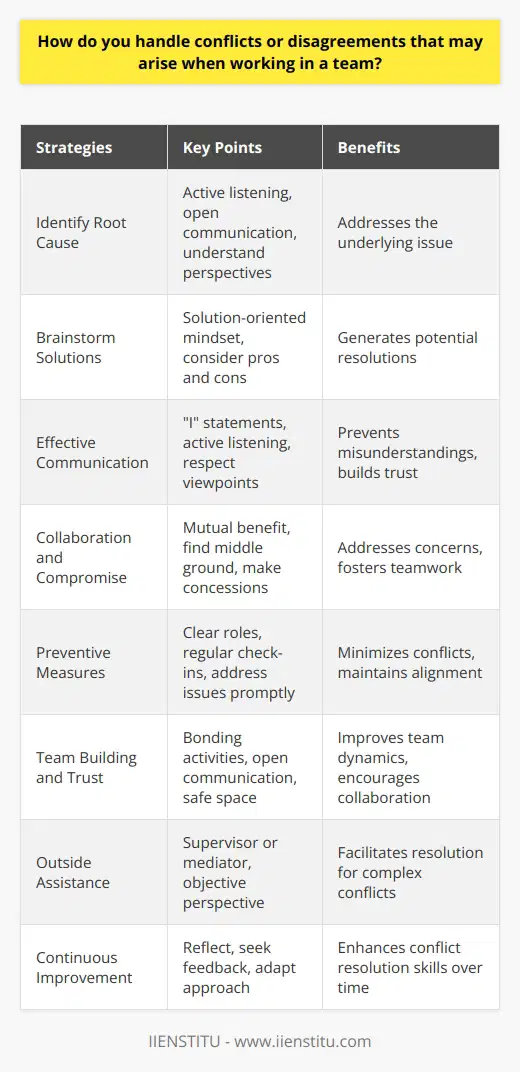
What strategies do you employ to foster effective communication and collaboration among team members?
Effective communication and collaboration among team members are essential for achieving successful outcomes in any project. Several strategies can be employed to foster a productive and cohesive team environment.
Establish Clear Roles and Responsibilities
Clearly defining each team member's role and responsibilities is crucial for effective collaboration. This helps everyone understand their specific tasks and how they contribute to the overall project goals. Regular check-ins and progress updates ensure that team members remain accountable and on track.
Encourage Open and Transparent Communication
Promoting open and transparent communication is vital for building trust and fostering collaboration within the team. Encourage team members to share their ideas, concerns, and feedback regularly. Create a safe and inclusive environment where everyone feels comfortable expressing their thoughts and opinions.
Utilize Communication Tools and Platforms
Leverage various communication tools and platforms to facilitate effective communication among team members. This can include project management software, instant messaging apps, video conferencing tools, and shared document platforms. These tools enable seamless collaboration, regardless of the team members' physical location.
Schedule Regular Team Meetings
Organize regular team meetings to discuss project progress, address any challenges, and brainstorm solutions. These meetings provide an opportunity for team members to align their efforts, share updates, and seek guidance or support when needed. Encourage active participation and ensure that everyone has a chance to contribute.
Foster a Culture of Active Listening
Encourage team members to practice active listening during discussions and meetings. This involves giving full attention to the speaker, avoiding interruptions, and seeking to understand their perspective before responding. Active listening promotes mutual respect, enhances understanding, and leads to more effective problem-solving.
Provide Constructive Feedback
Regularly provide constructive feedback to team members to help them grow and improve their performance. Offer specific, actionable insights that focus on behaviors and outcomes rather than personal attributes. Encourage team members to seek feedback from one another and create a culture of continuous learning and development.
Celebrate Successes and Milestones
Recognize and celebrate the team's successes and milestones throughout the project. Acknowledging achievements boosts morale, strengthens team bonds, and motivates members to continue their hard work. Celebrate both individual and collective accomplishments to foster a sense of shared ownership and pride in the team's progress.
Encourage Informal Interactions
Promote informal interactions among team members to build stronger relationships and enhance collaboration. Organize team-building activities, casual gatherings, or virtual coffee breaks to create opportunities for team members to connect on a personal level. These informal interactions can help break down barriers and foster a more cohesive and supportive team environment.
By implementing these strategies, leaders can create a collaborative and communicative team culture that drives success. Effective communication and collaboration enable team members to work together seamlessly, leverage each other's strengths, and achieve their shared goals more efficiently.
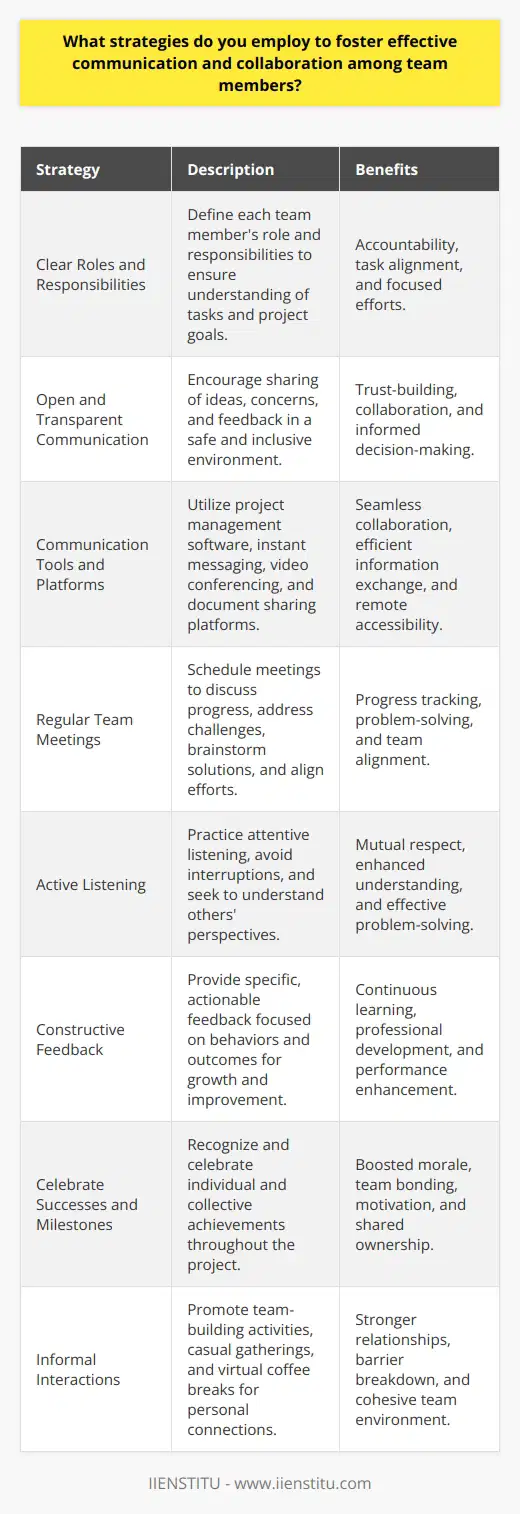
How do you handle conflicts or disagreements that may arise within a team?
Handling conflicts or disagreements within a team requires a proactive and empathetic approach. The first step is to acknowledge the existence of the conflict and address it promptly. Ignoring or avoiding the issue can lead to further escalation and negatively impact team dynamics and productivity.
Encourage Open Communication
Foster an environment where team members feel comfortable expressing their concerns and opinions. Encourage active listening and ensure that each person has the opportunity to voice their perspective without interruption. Create a safe space for open dialogue, where individuals can share their thoughts and feelings without fear of judgment or retaliation.
Practice Active Listening
When a team member expresses their concerns, practice active listening. Give them your full attention and try to understand their point of view. Ask clarifying questions to gain a better understanding of their perspective. Avoid interrupting or jumping to conclusions before they have finished speaking.
Identify the Root Cause
Once all parties have had the chance to express their concerns, work together to identify the root cause of the conflict. Often, disagreements arise due to misunderstandings, miscommunication, or differing expectations. By pinpointing the underlying issues, you can begin to find common ground and work towards a resolution.
Encourage Collaboration and Compromise
Encourage team members to collaborate and find mutually beneficial solutions. Emphasize the importance of compromise and finding a middle ground that addresses everyone's concerns. Encourage brainstorming sessions where team members can propose creative solutions and work together to find a resolution that benefits the entire team.
Mediate the Discussion
If the conflict escalates or team members struggle to find a resolution, consider acting as a mediator. Facilitate the discussion and ensure that each person has the opportunity to express their perspective. Help guide the conversation towards a constructive resolution, focusing on finding common goals and objectives.
Establish Clear Expectations and Guidelines
To prevent future conflicts, establish clear expectations and guidelines for team communication and collaboration. Develop a team charter that outlines roles, responsibilities, and communication protocols. Regularly review and update these guidelines to ensure they remain relevant and effective.
Provide Conflict Resolution Training
Invest in conflict resolution training for team members. Equip them with the skills and tools necessary to effectively handle disagreements and communicate assertively. Encourage team members to attend workshops or seminars that focus on interpersonal communication, active listening, and problem-solving techniques.
Lead by Example
As a team leader, it is essential to lead by example. Model the behavior you expect from your team members. Demonstrate active listening, empathy, and a willingness to find collaborative solutions. When conflicts arise, remain calm and objective, focusing on finding a resolution that benefits the entire team.
Remember, conflicts and disagreements are a natural part of teamwork. By addressing them proactively and constructively, you can foster a positive team dynamic and create an environment where everyone feels valued and respected. Encourage open communication, collaboration, and a commitment to finding mutually beneficial solutions to ensure the long-term success and productivity of your team.
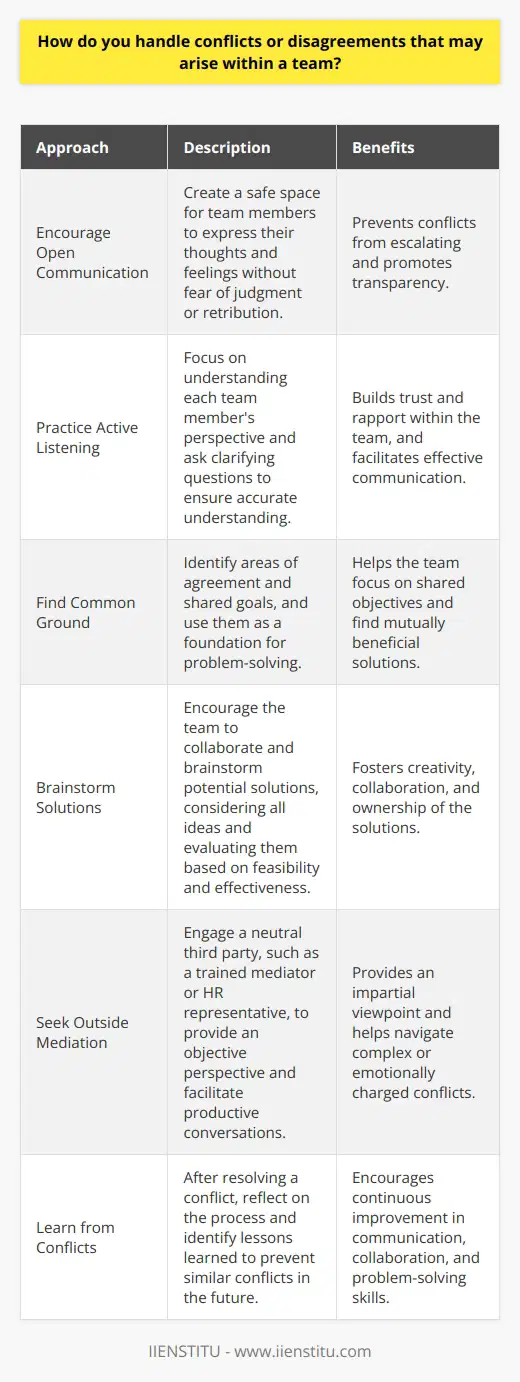
Can you describe a time when you successfully contributed to a team project and what role did you play in its success?
In my experience, successfully contributing to a team project requires effective communication, collaboration, and a willingness to take on responsibility. During my time as a marketing intern at XYZ Company, I played a crucial role in the success of a new product launch campaign. By actively participating in team meetings, offering creative ideas, and taking the initiative to conduct market research, I helped shape the direction of the project.
Effective Communication and Collaboration
One of the key factors in our team's success was maintaining open lines of communication. I made sure to actively listen to my teammates' ideas and provide constructive feedback. By fostering a collaborative environment, we were able to bounce ideas off each other and come up with innovative solutions to the challenges we faced. Regular check-ins and progress updates helped keep everyone on the same page and ensured that we were working towards our common goal.
Taking Initiative and Responsibility
I recognized that to make a meaningful contribution to the project, I needed to take initiative and ownership of my tasks. I volunteered to conduct market research to gain insights into our target audience's preferences and behavior. By analyzing competitor strategies and identifying potential gaps in the market, I provided valuable information that helped shape our marketing approach. I also took responsibility for creating engaging social media content and monitoring the campaign's performance, making data-driven suggestions for optimization.
Adapting to Challenges and Changes
Throughout the project, we encountered various challenges and unexpected changes in direction. I remained flexible and adaptable, quickly adjusting my approach to align with the team's needs. When faced with tight deadlines, I prioritized my tasks and put in extra effort to ensure that my contributions were delivered on time and to a high standard. By being proactive and willing to step up when needed, I demonstrated my commitment to the project's success.
The Impact of Teamwork
Our team's collaborative efforts paid off, and the product launch campaign exceeded expectations. We achieved strong sales numbers and received positive feedback from customers. I learned that the success of a team project relies on the collective efforts and contributions of each team member. By leveraging our individual strengths, communicating effectively, and working towards a shared vision, we were able to achieve our goals and deliver outstanding results.
Lessons Learned
This experience taught me the importance of being an active and engaged team member. I learned that success is not just about individual contributions but also about how well you work with others towards a common objective. By fostering a collaborative spirit, taking initiative, and being adaptable, I was able to make a positive impact on the project's outcome. These lessons have stayed with me and continue to guide my approach to teamwork in both academic and professional settings.
